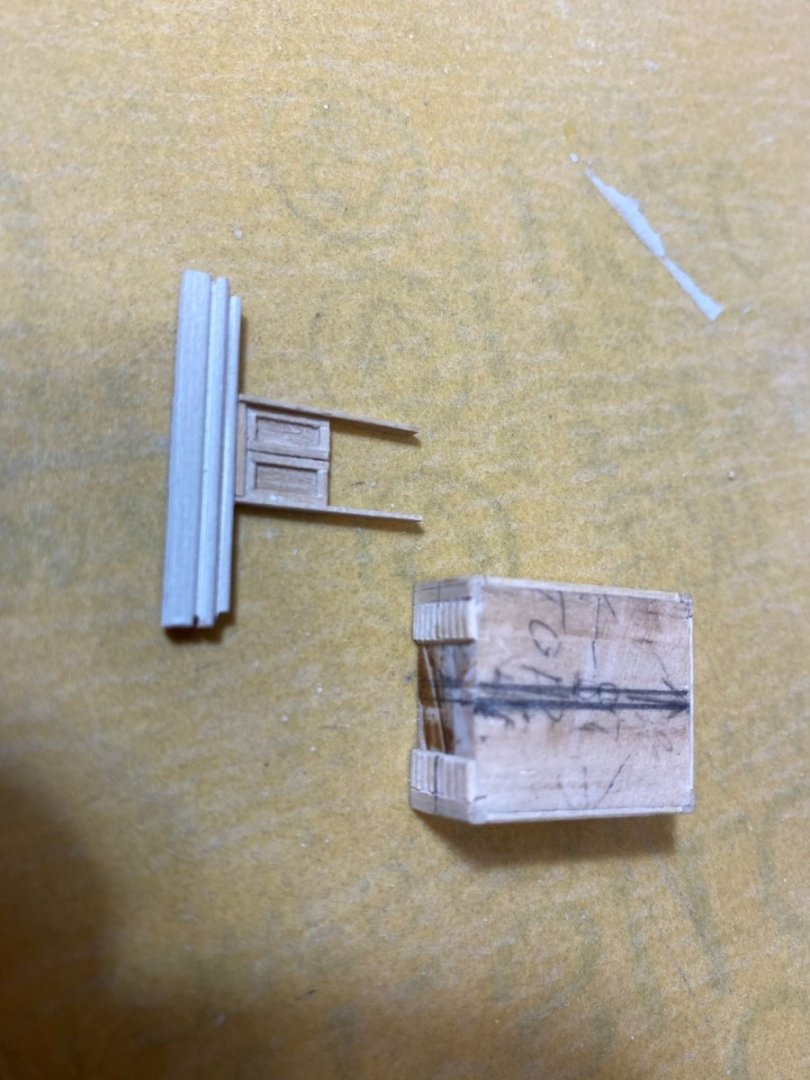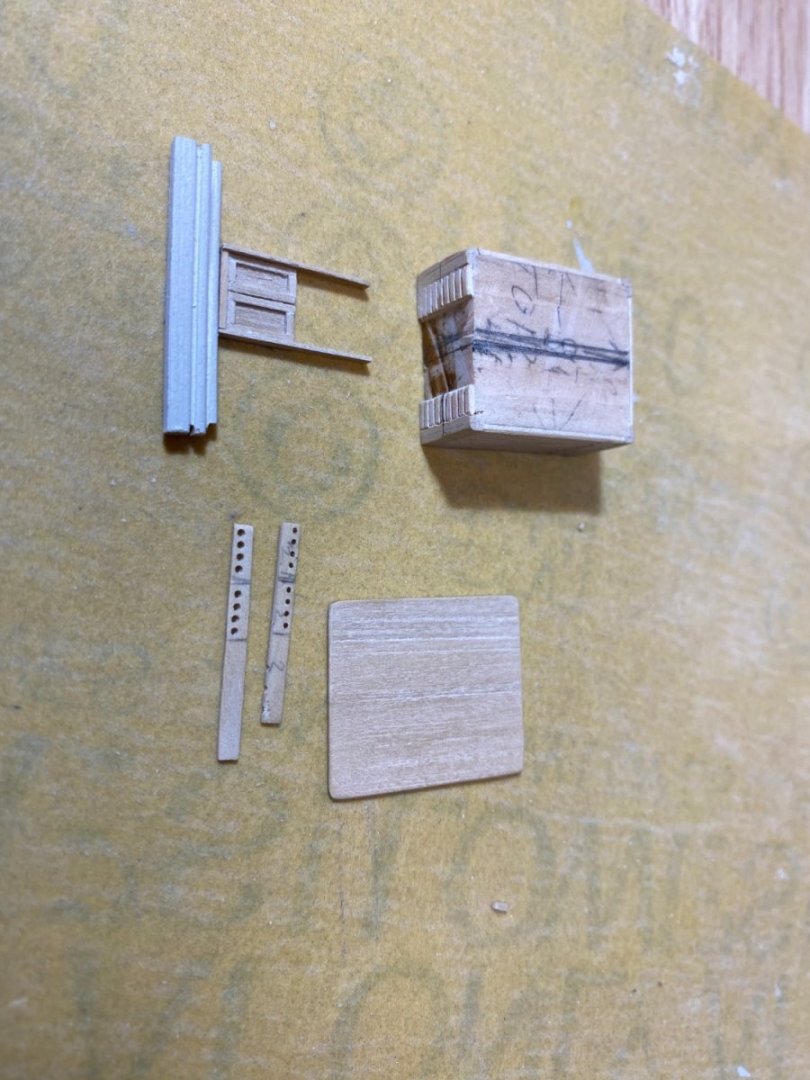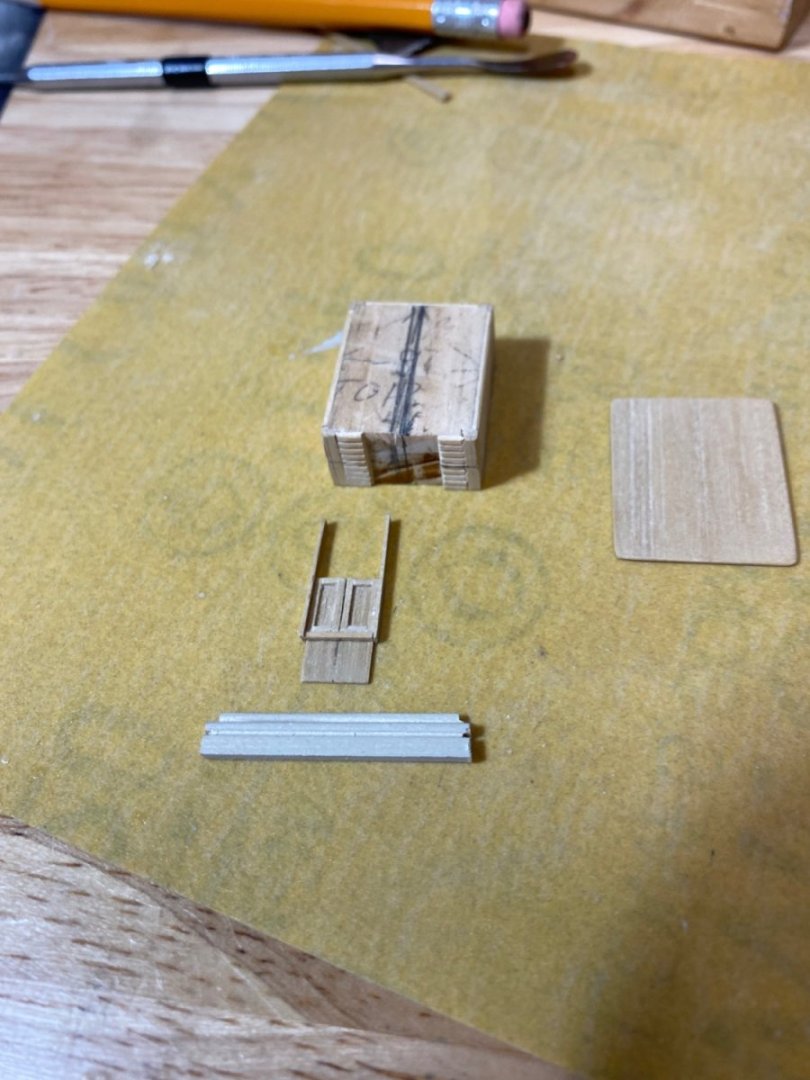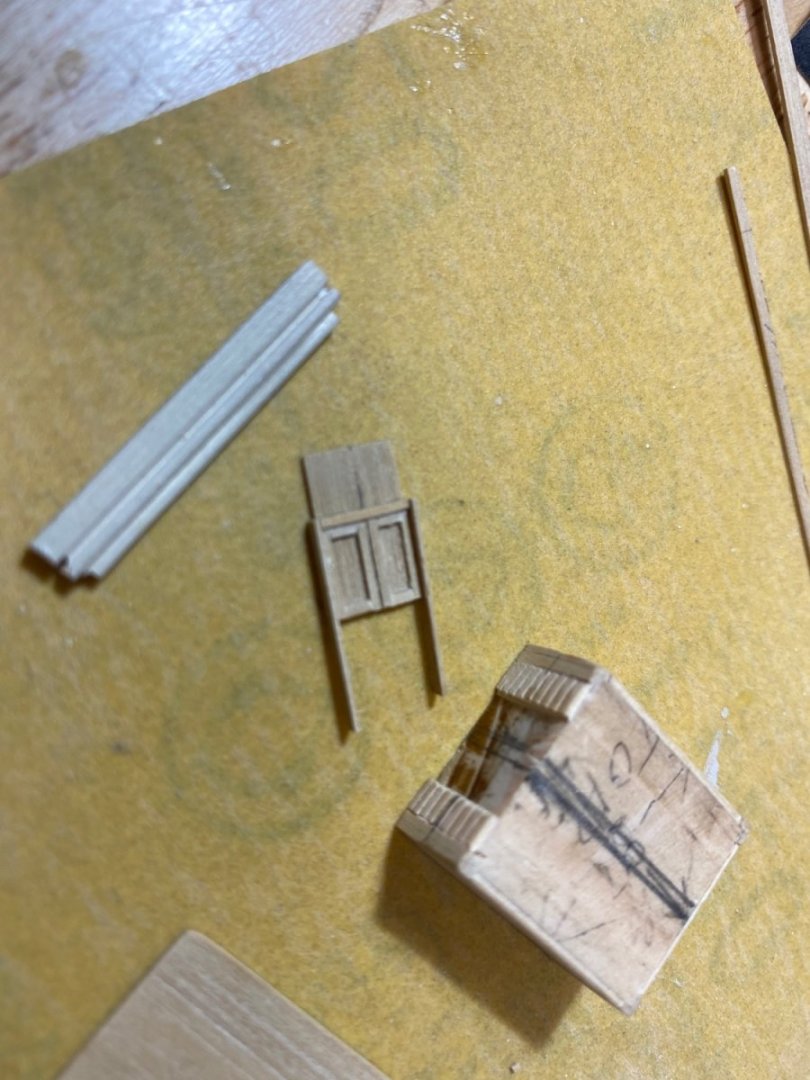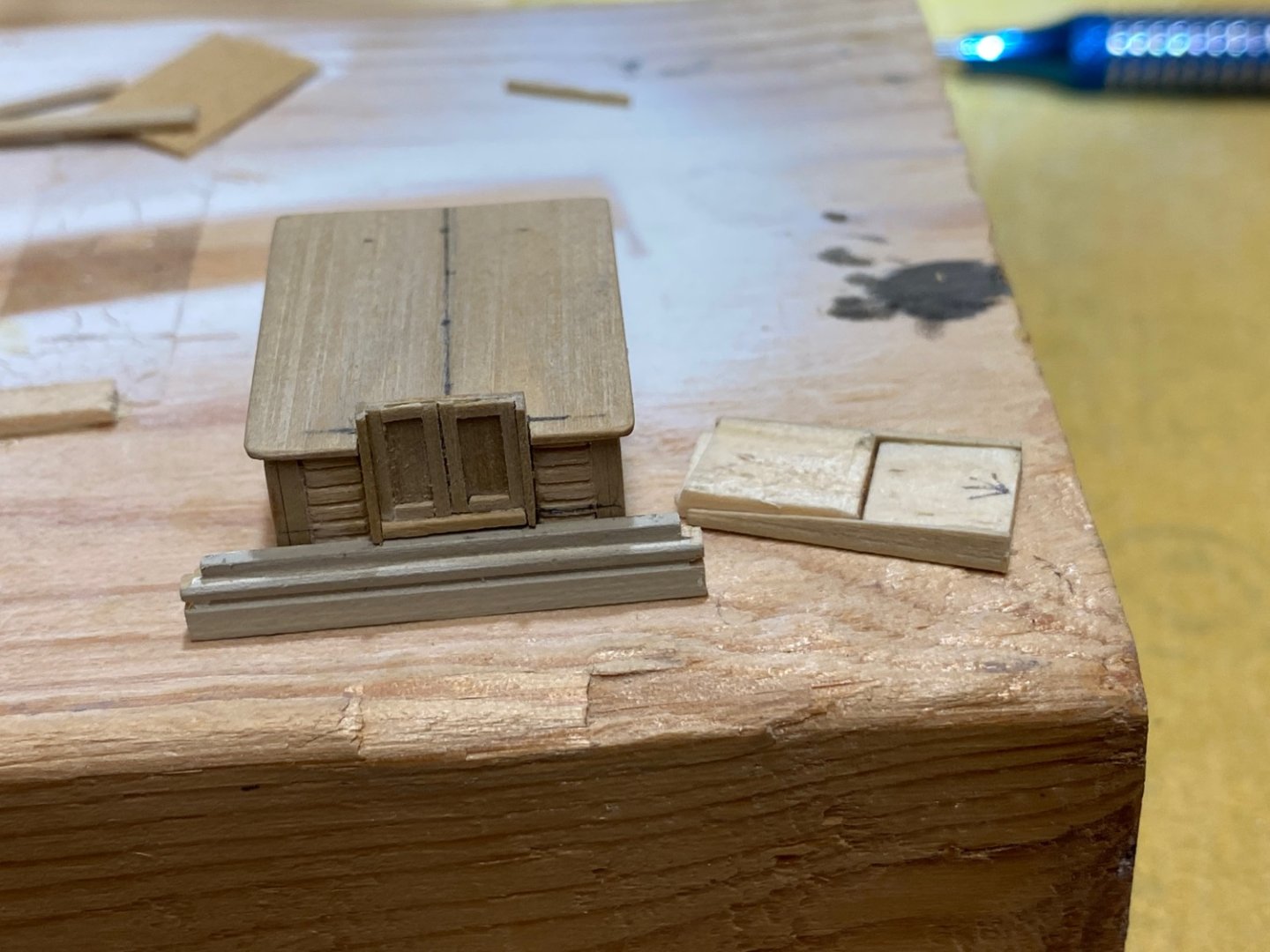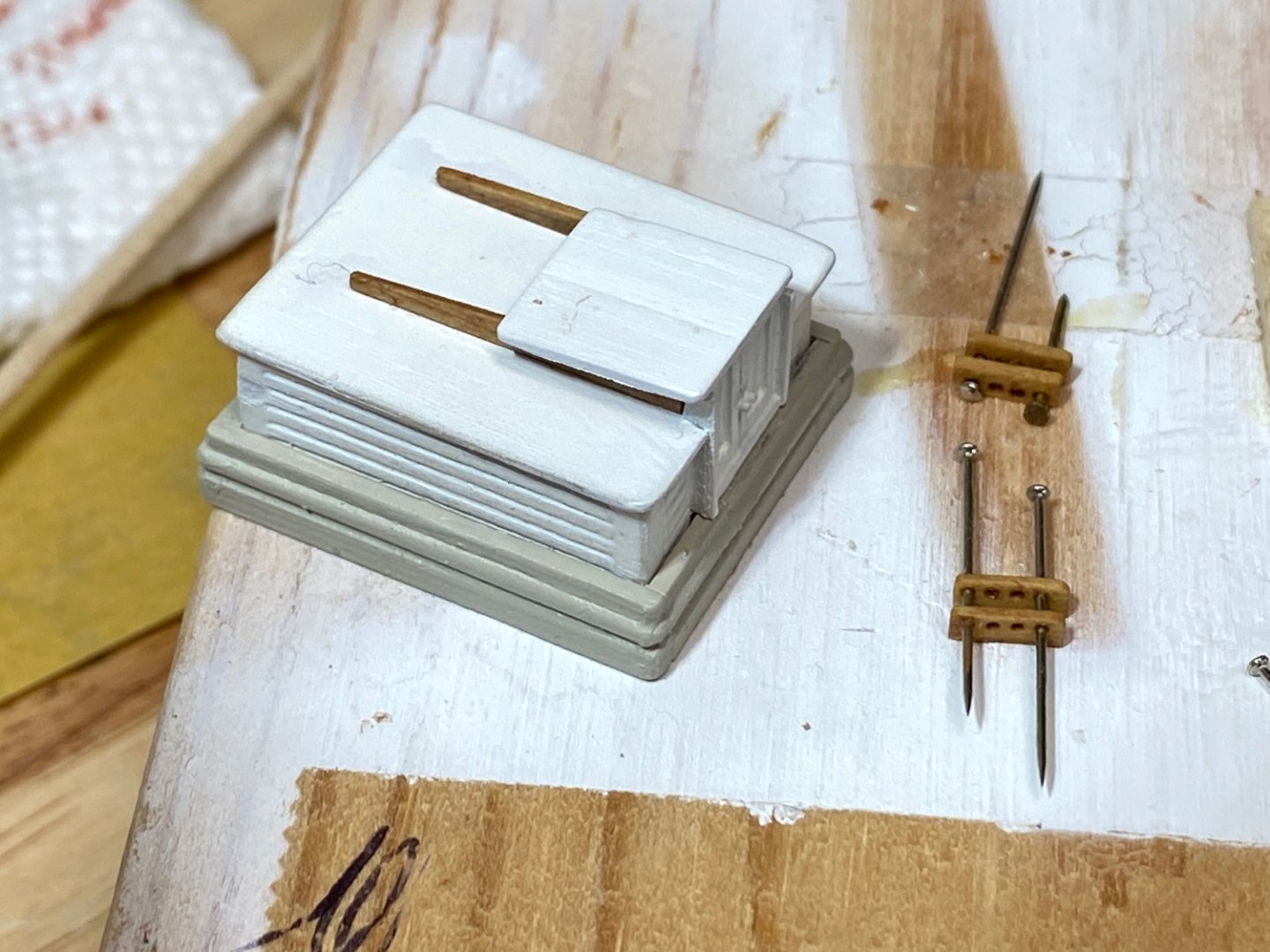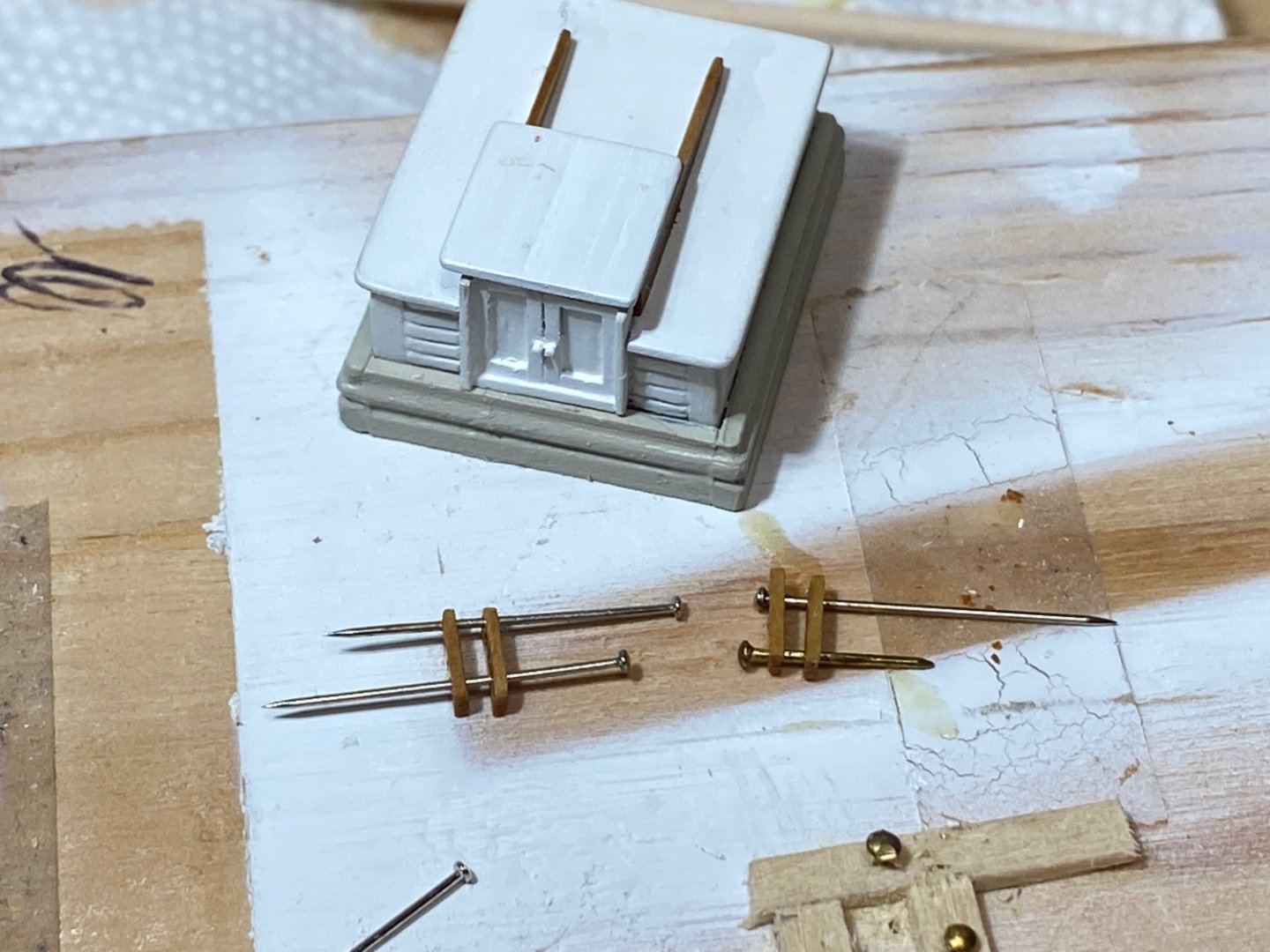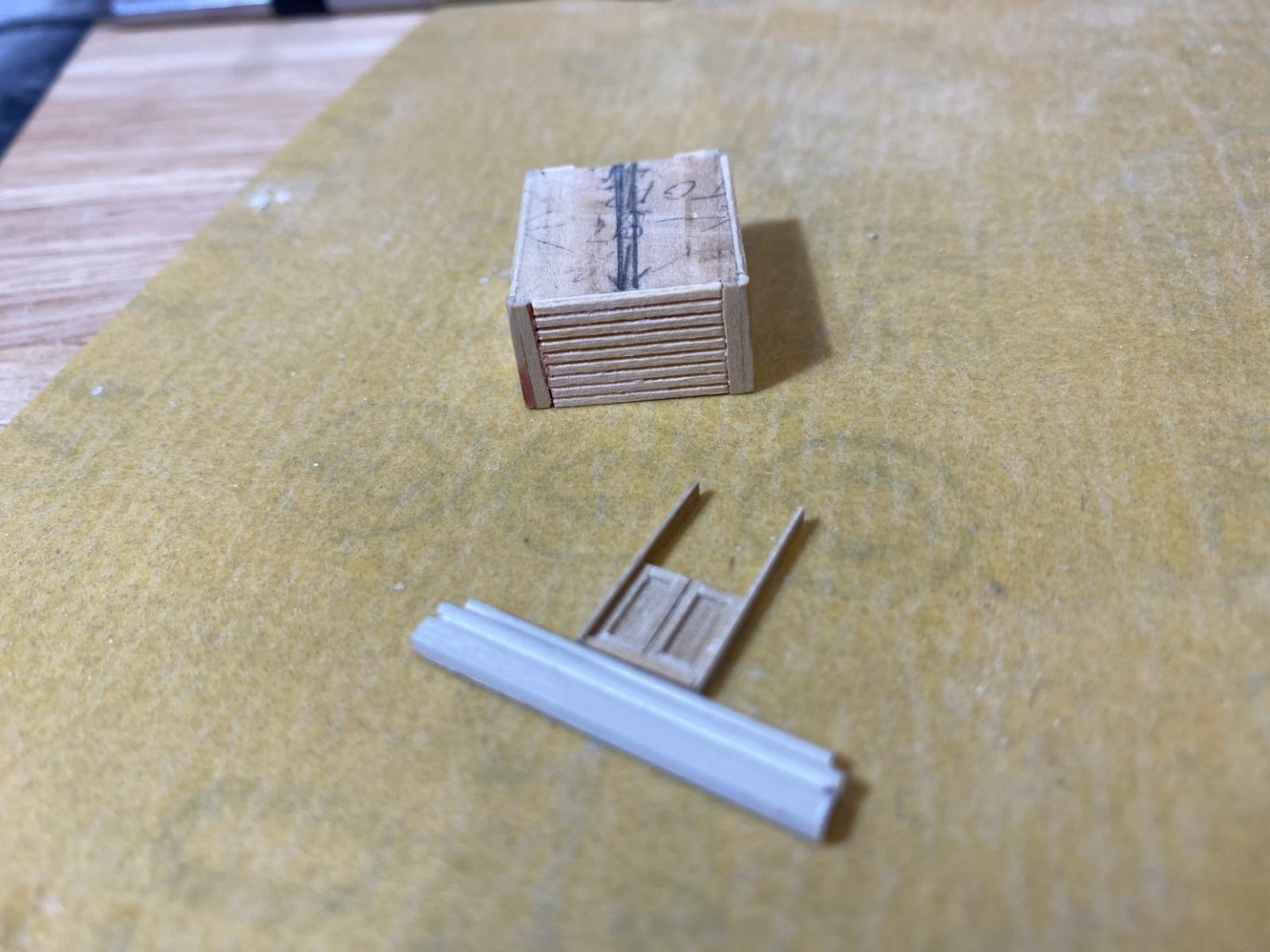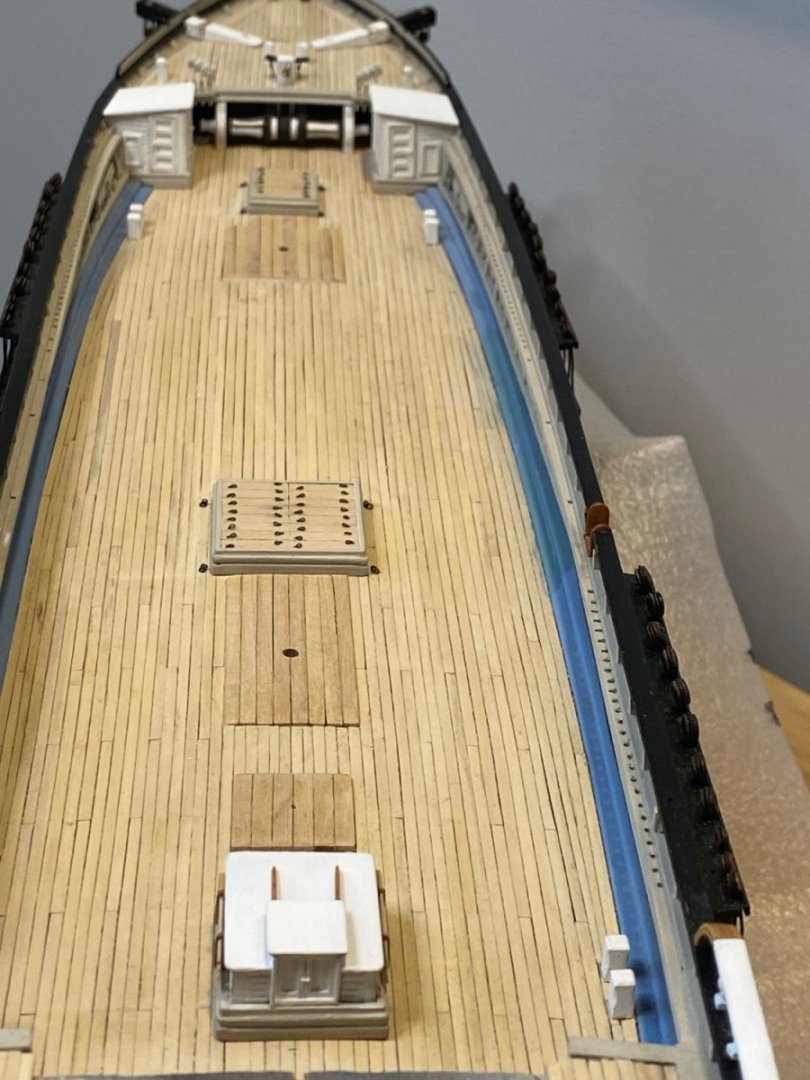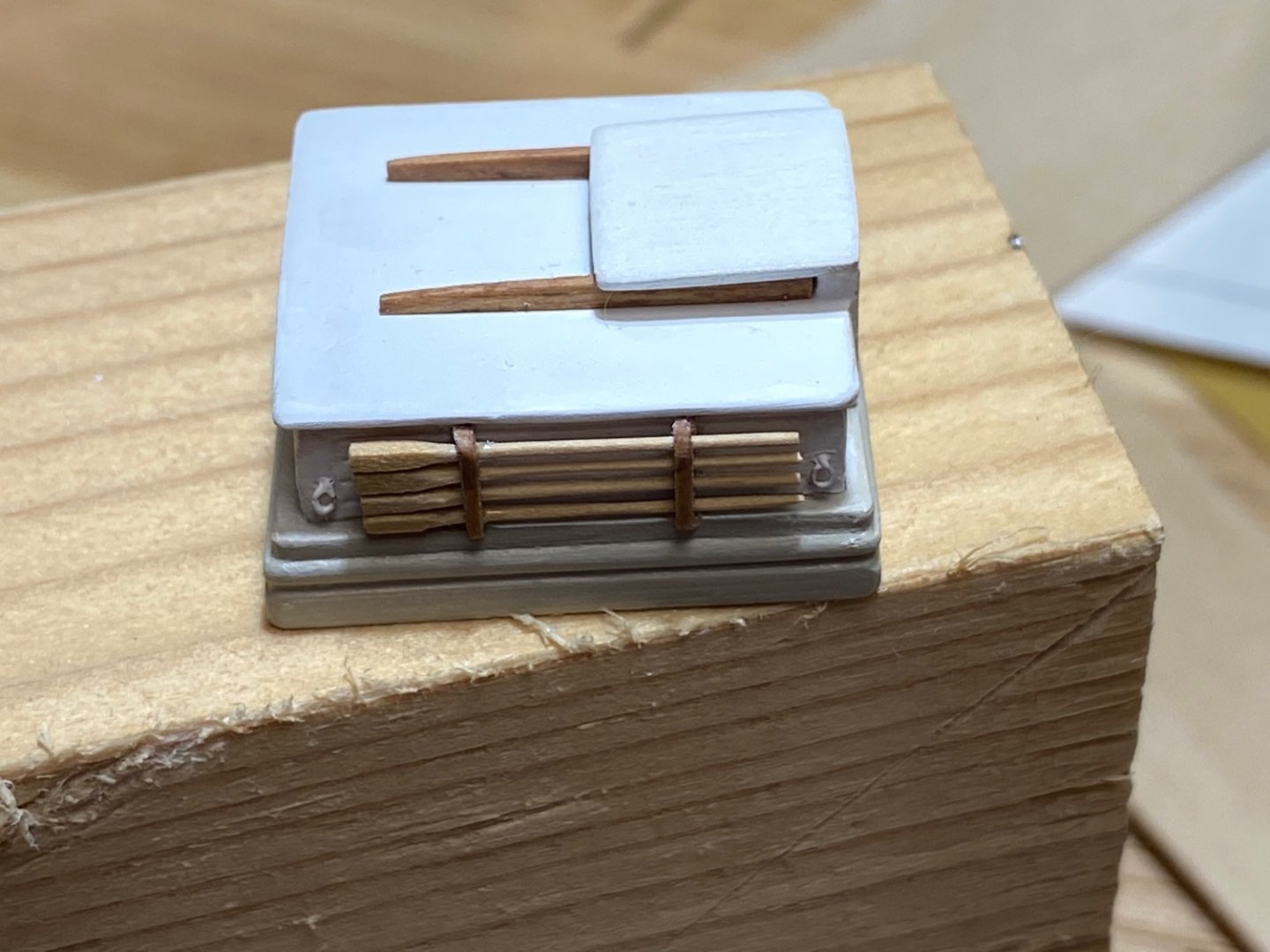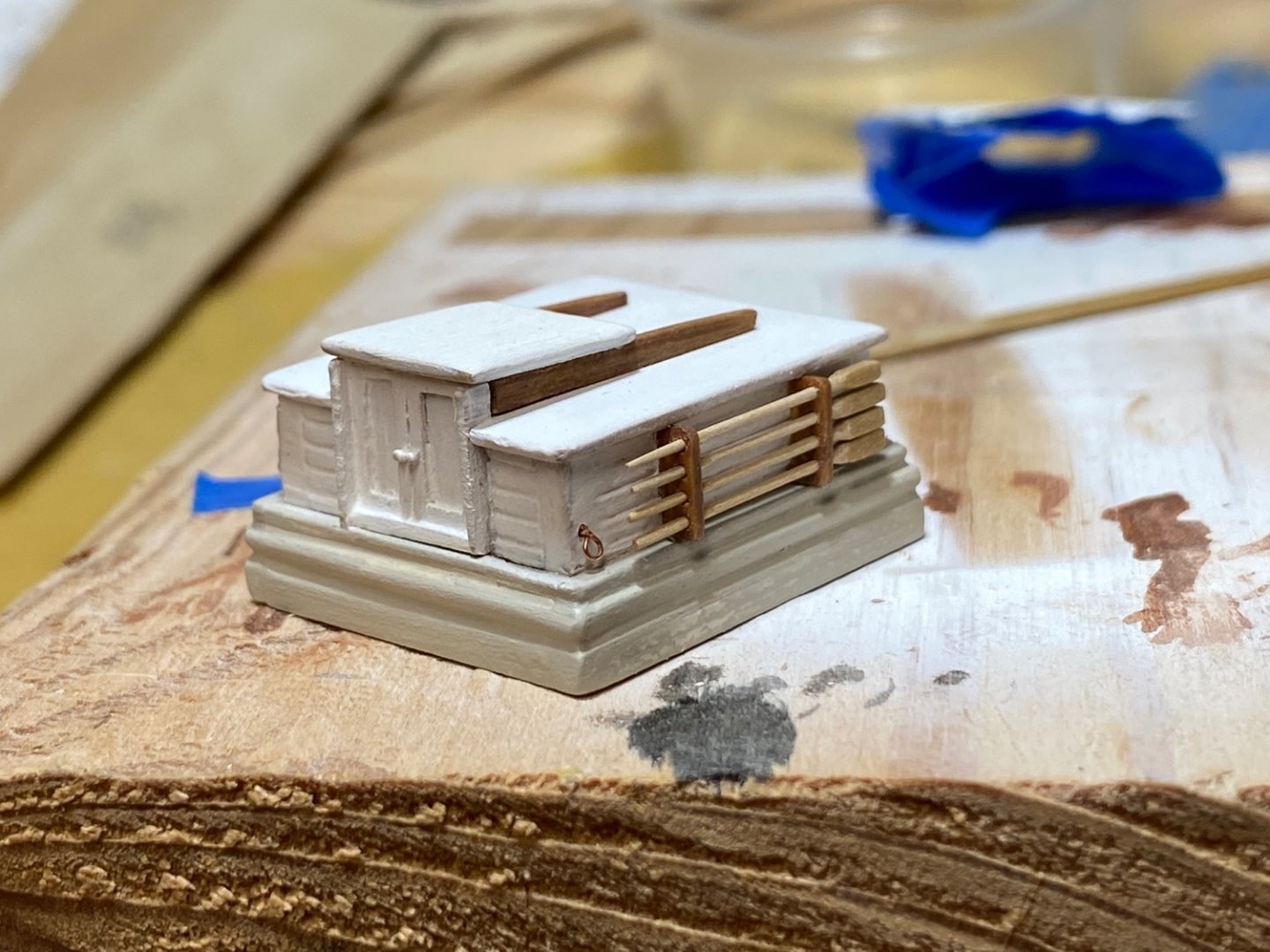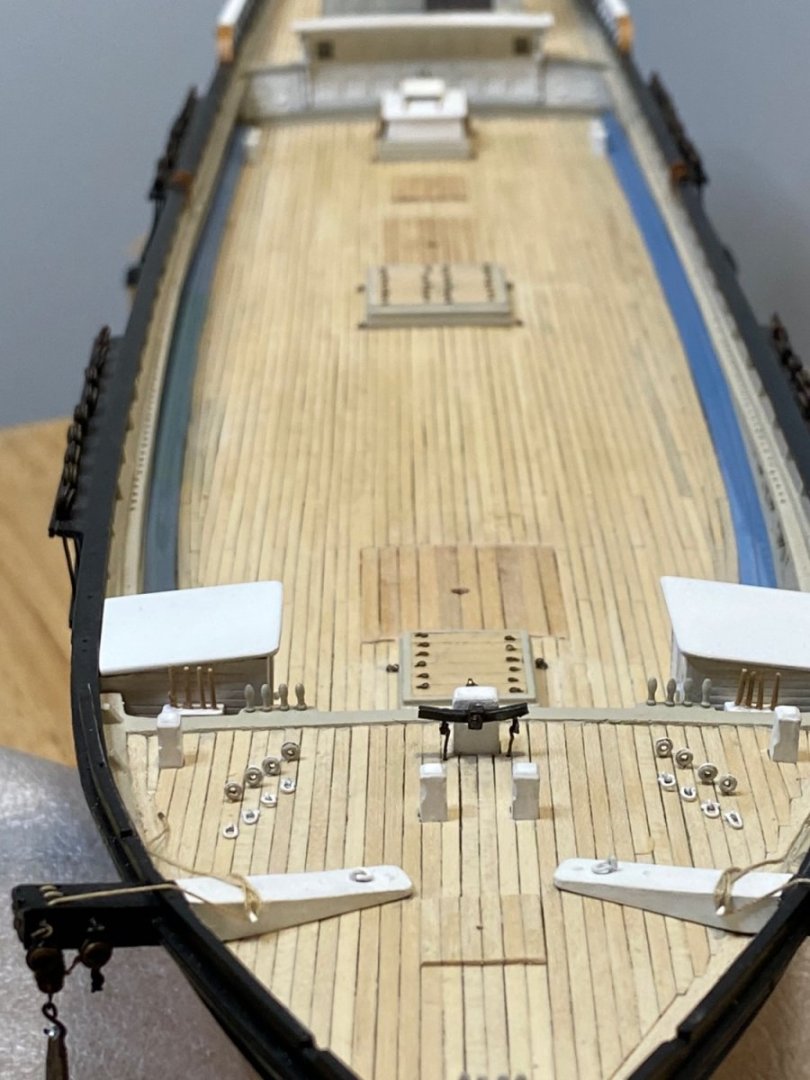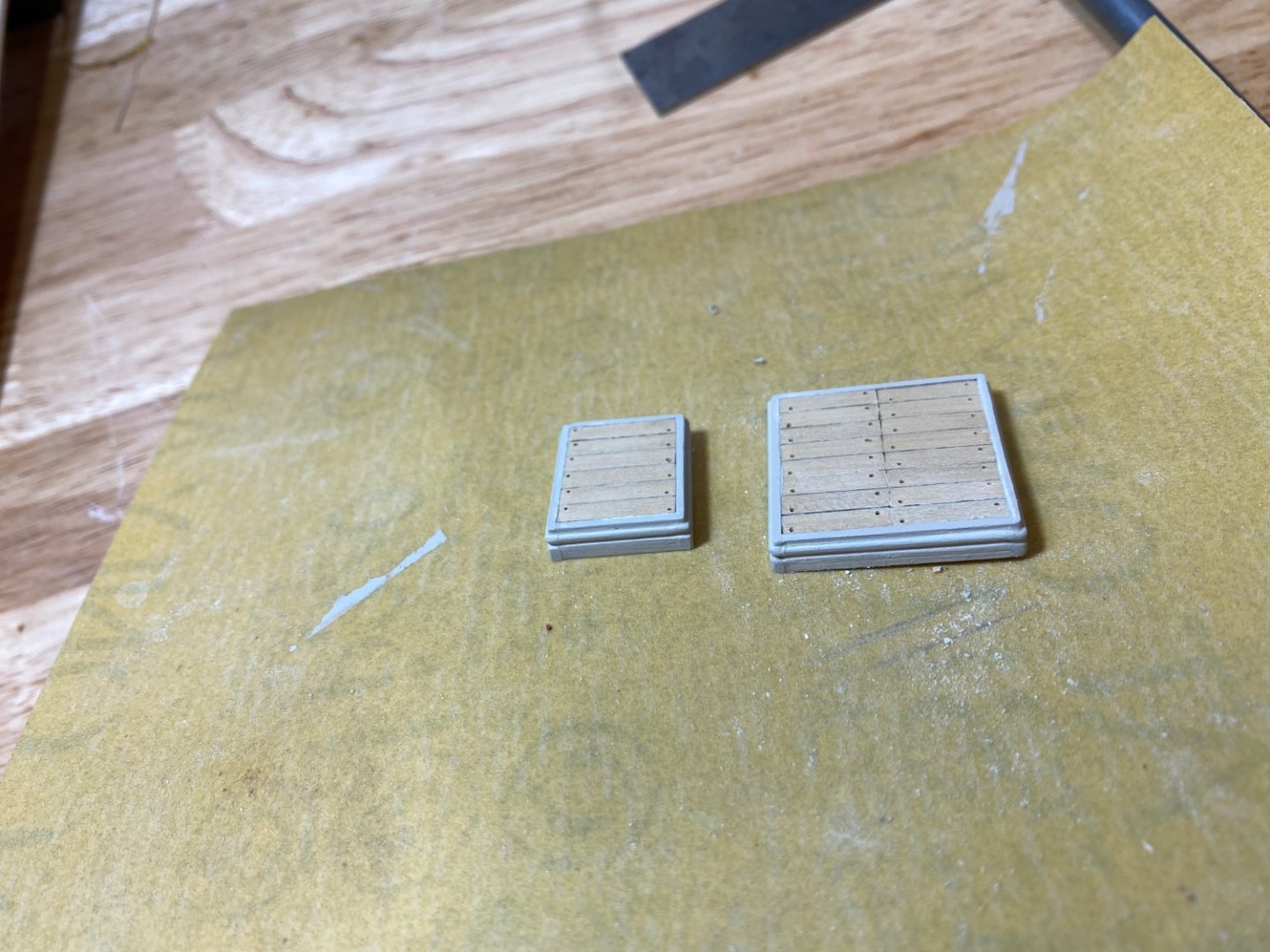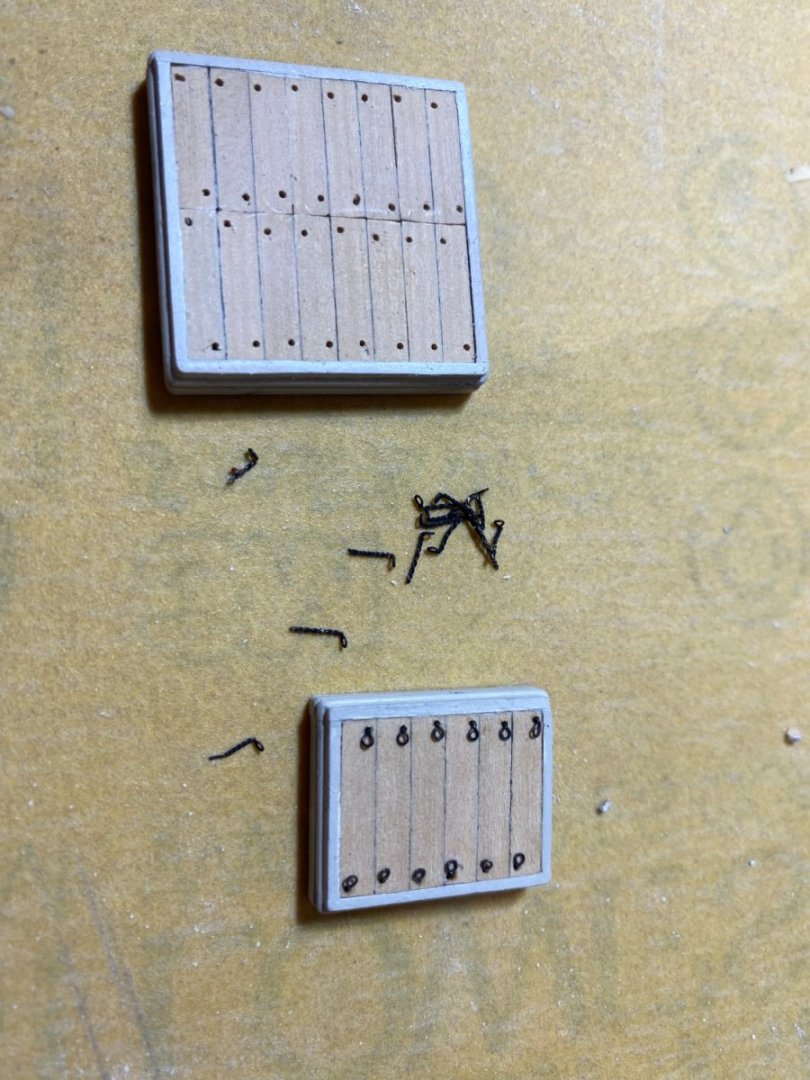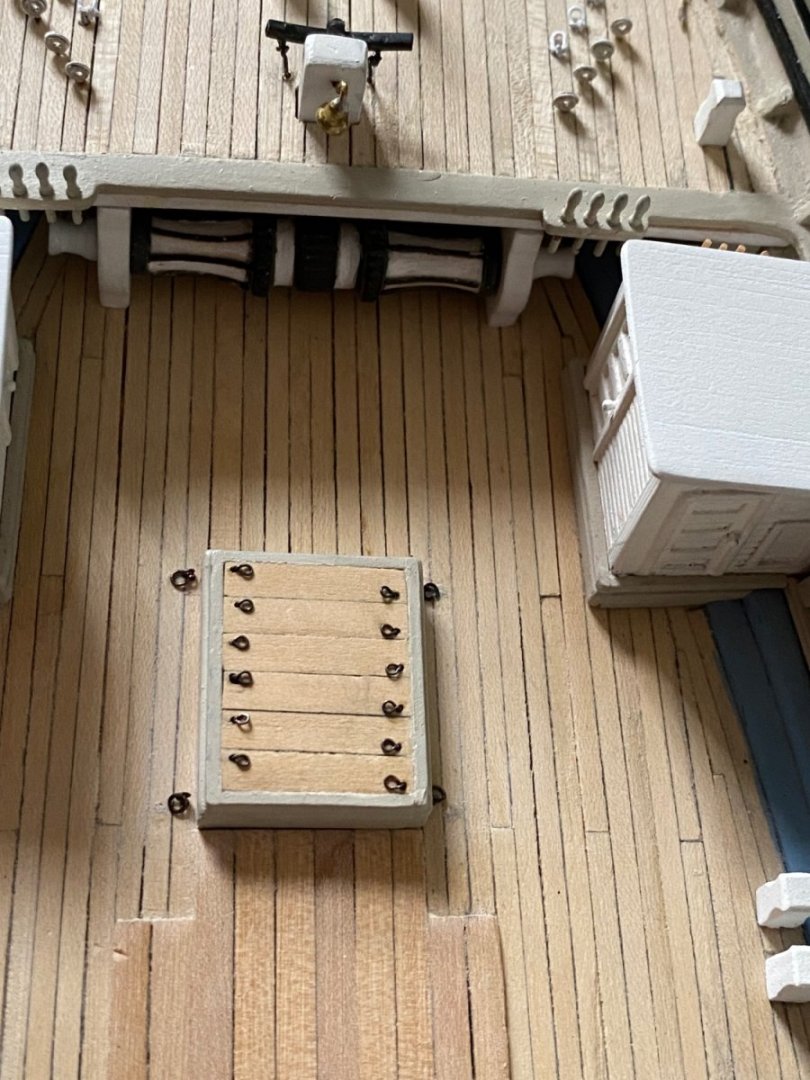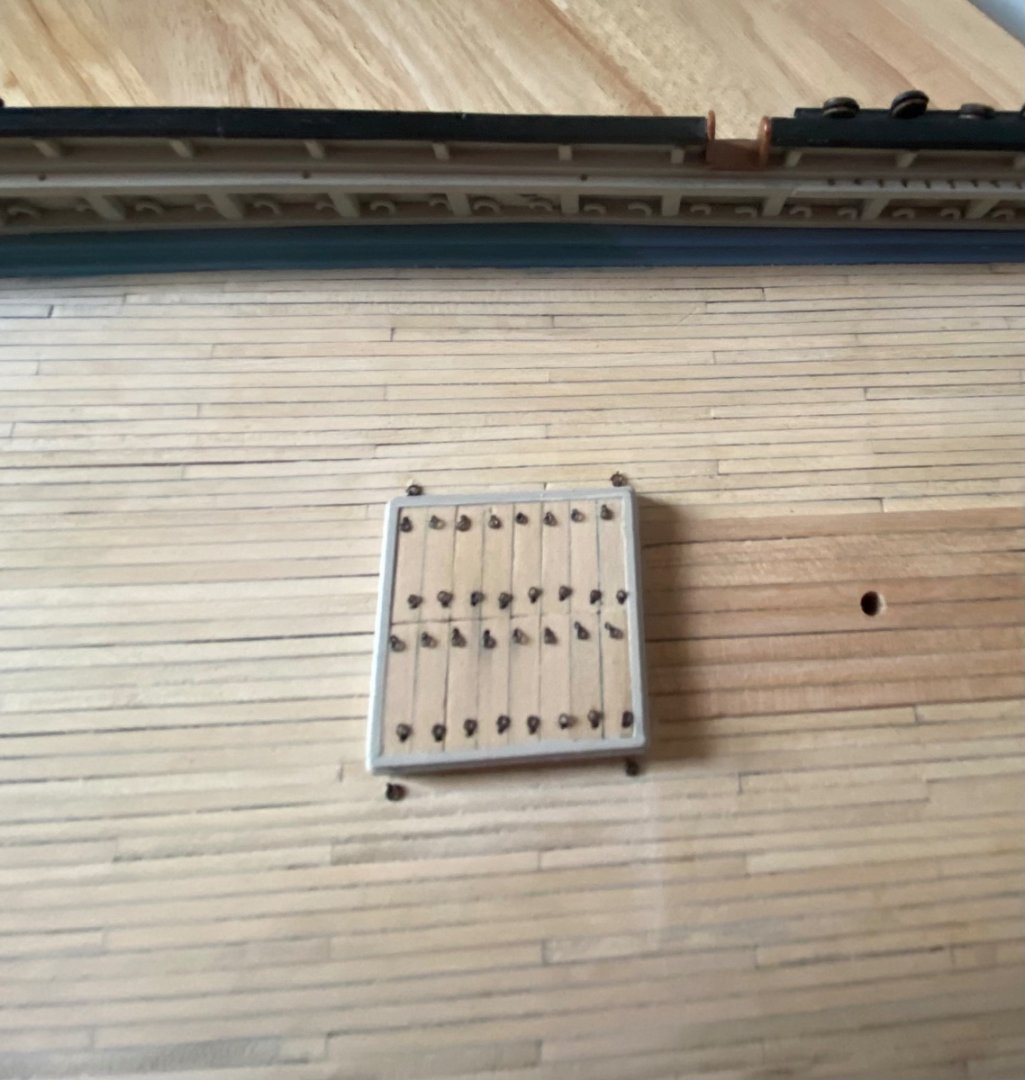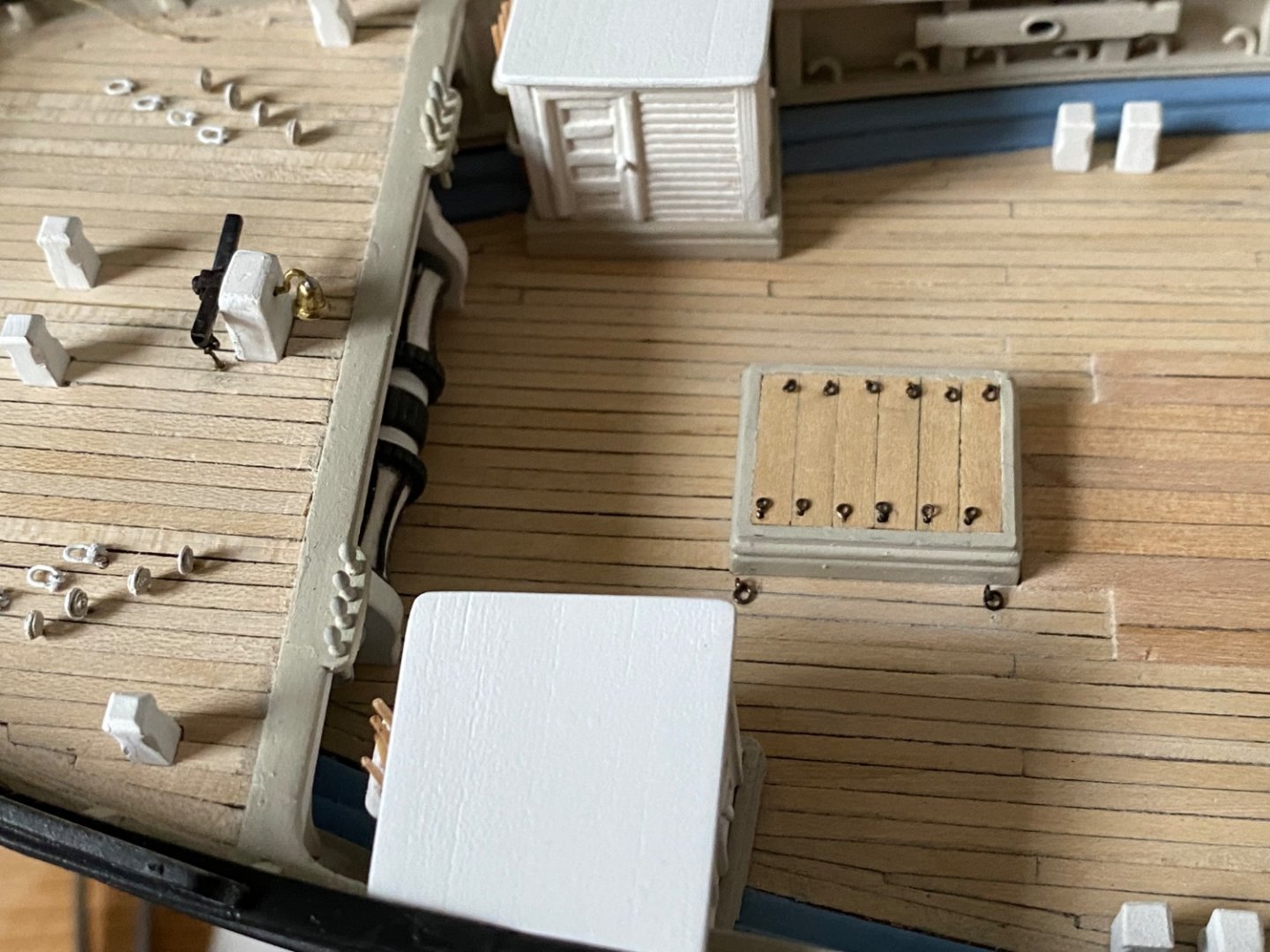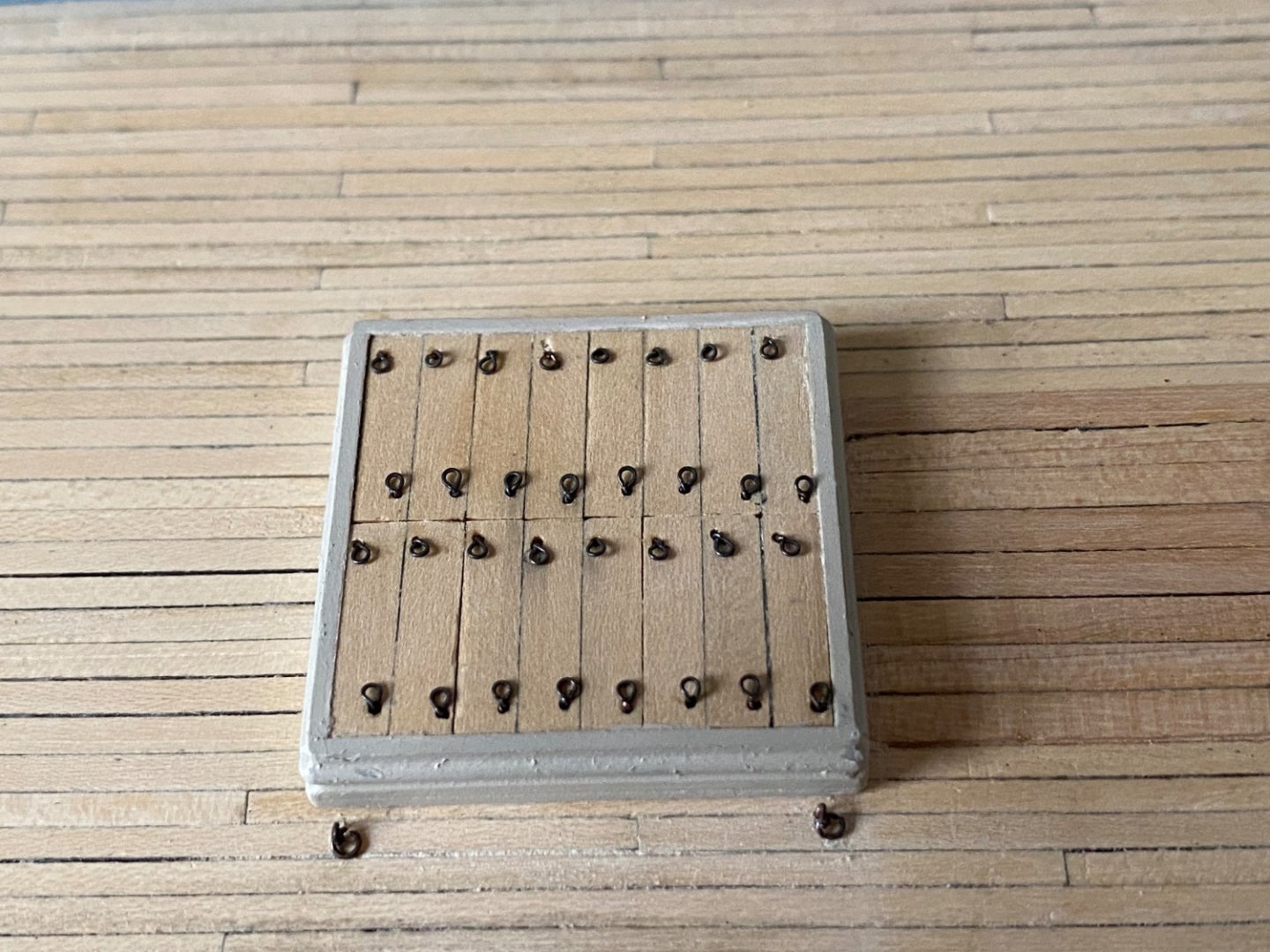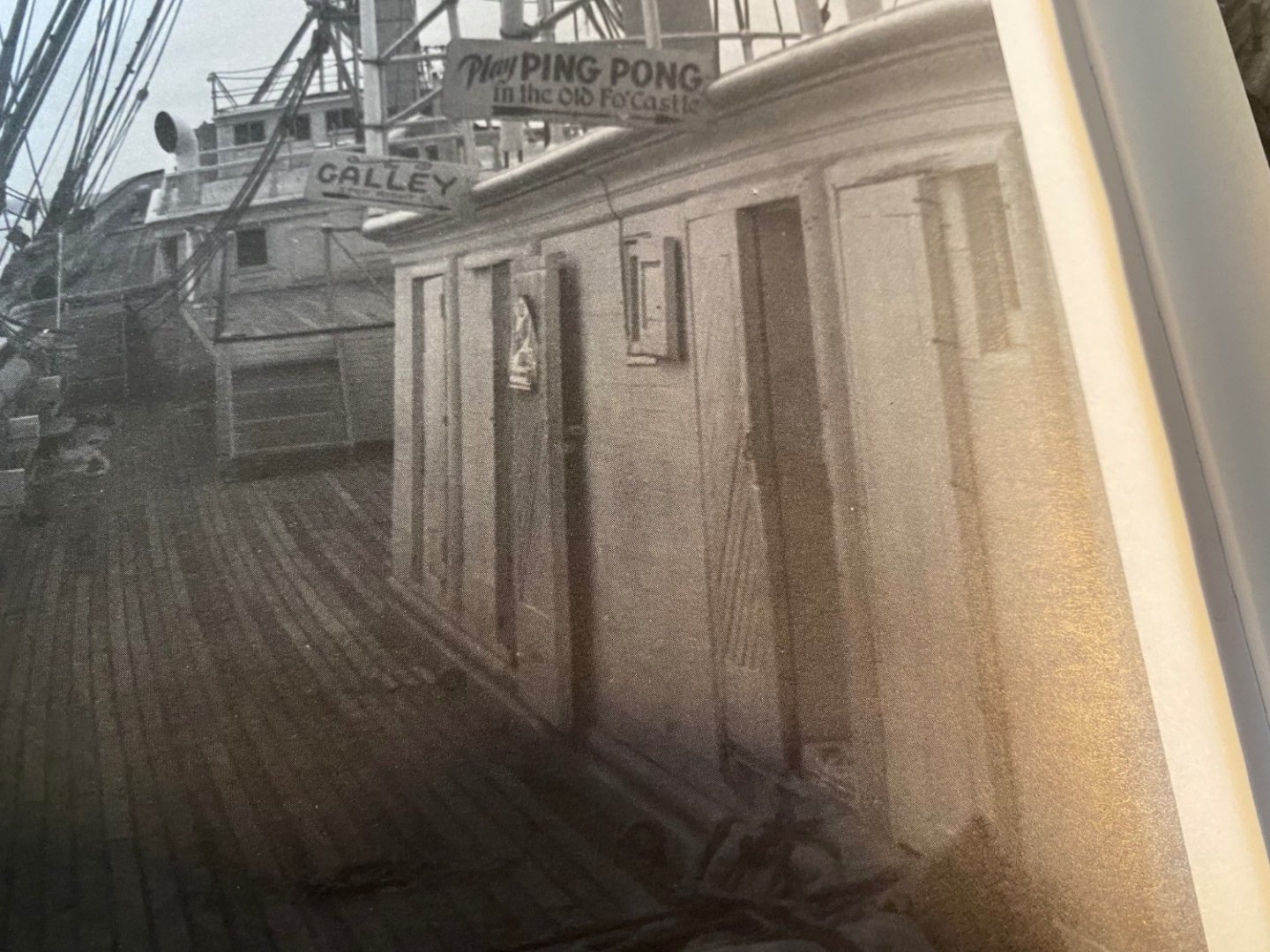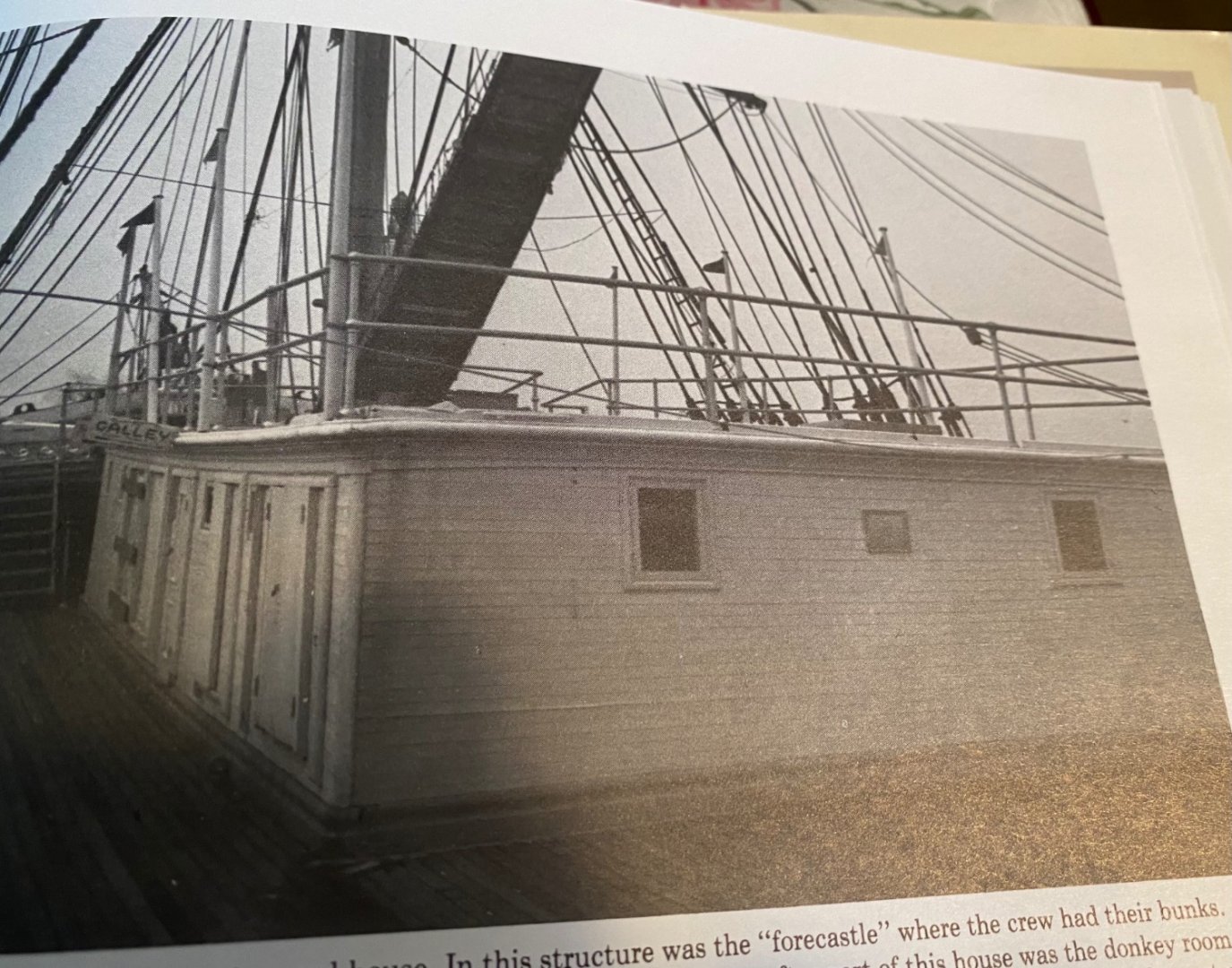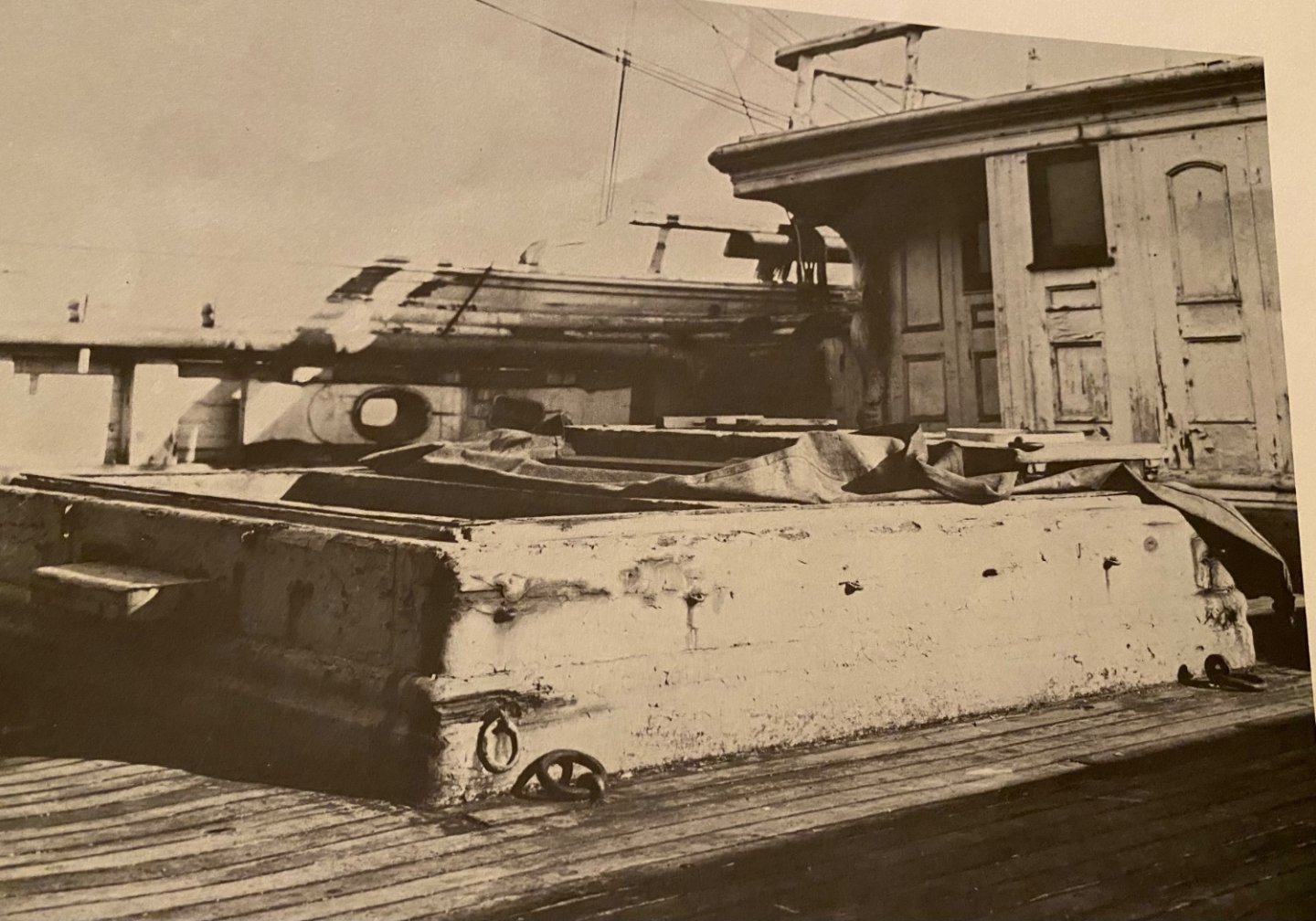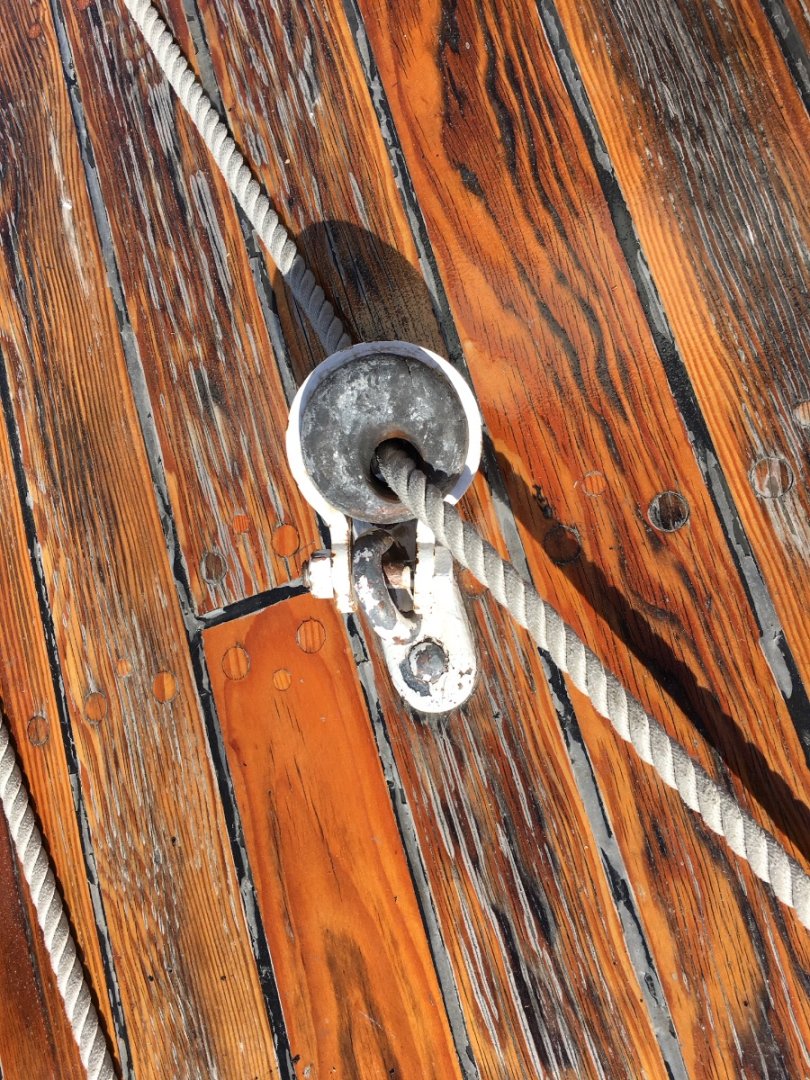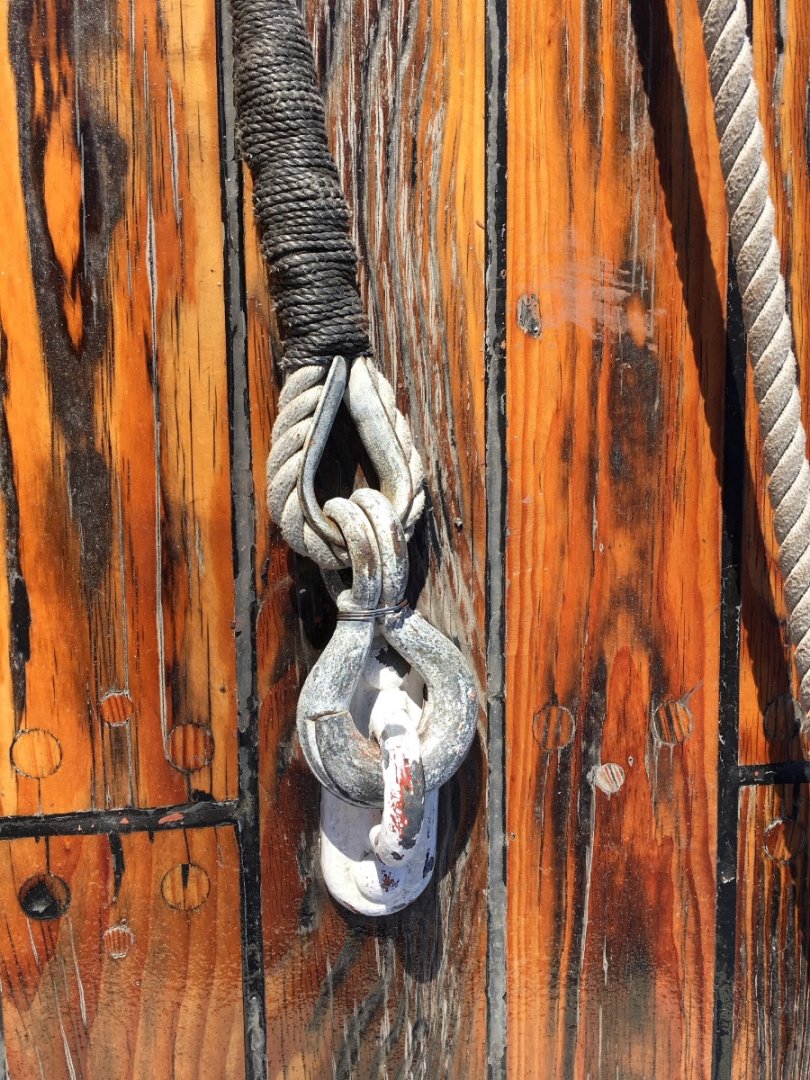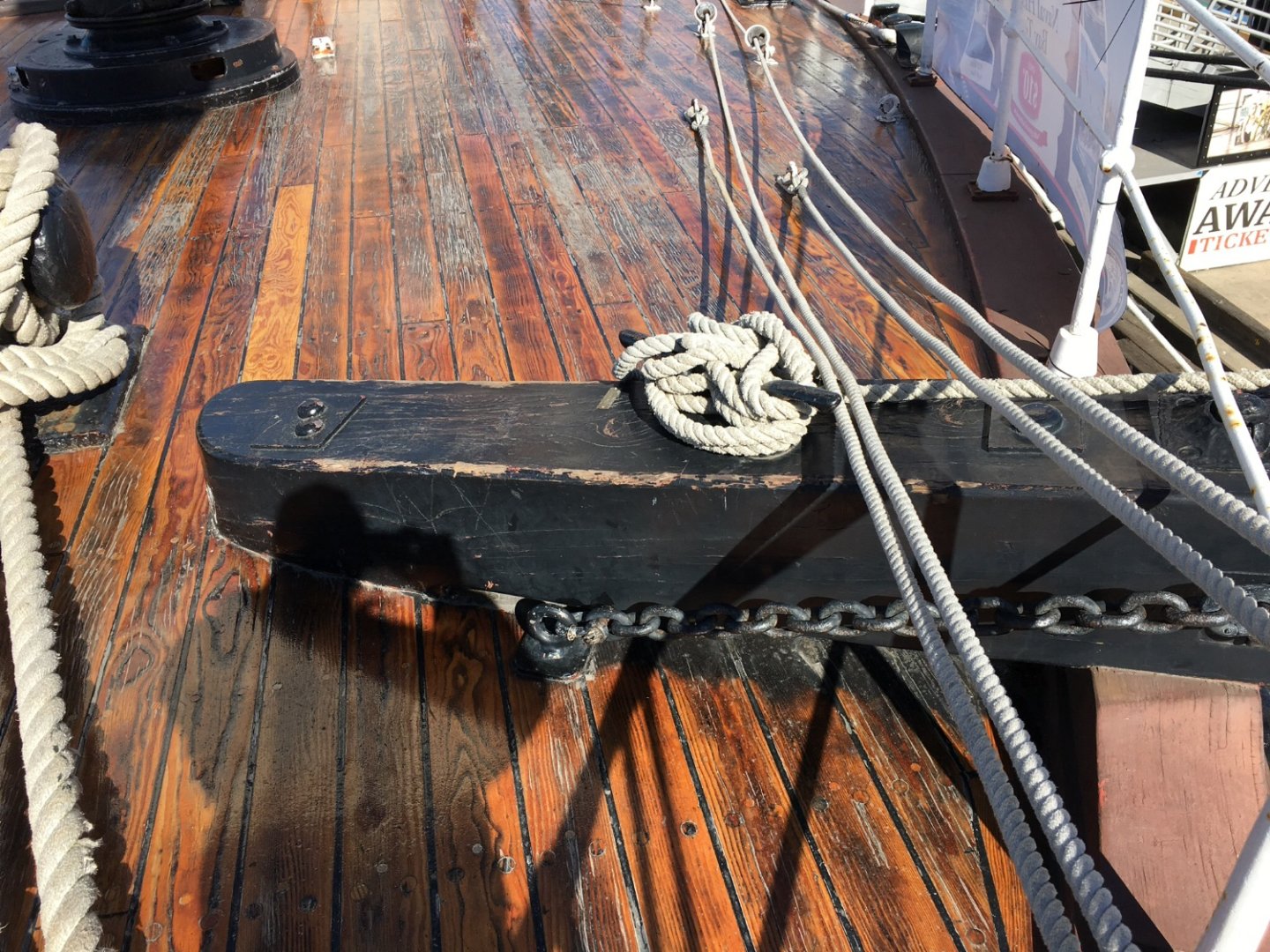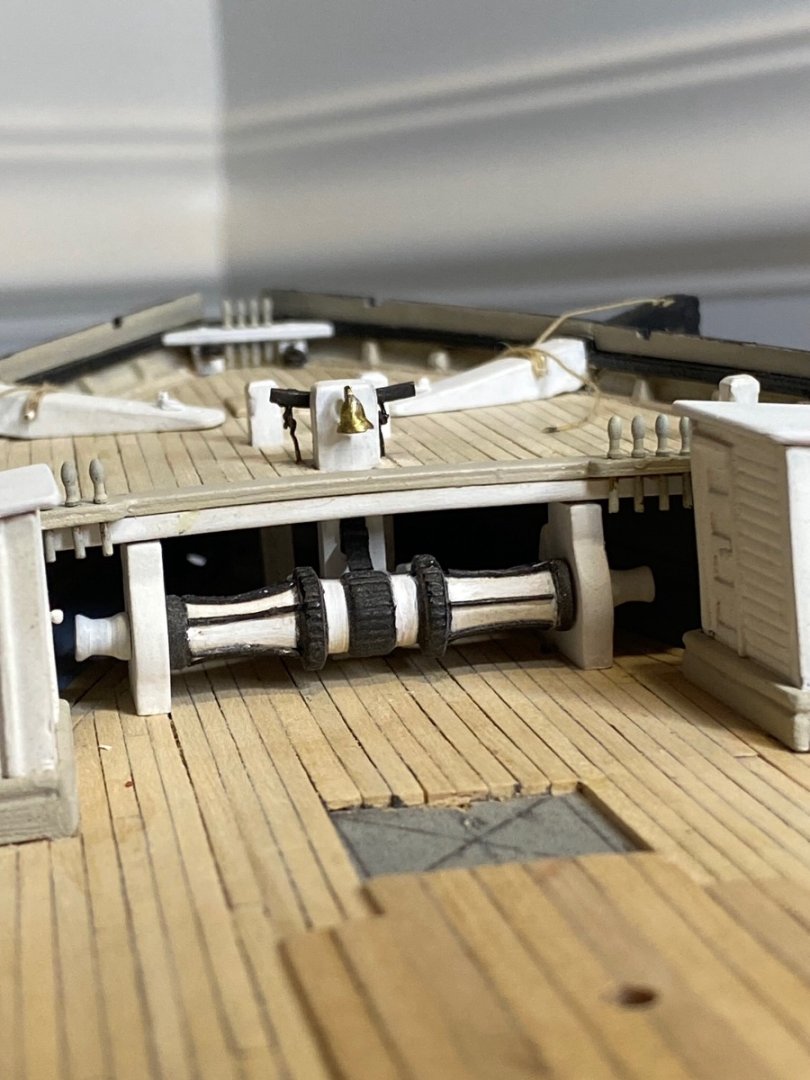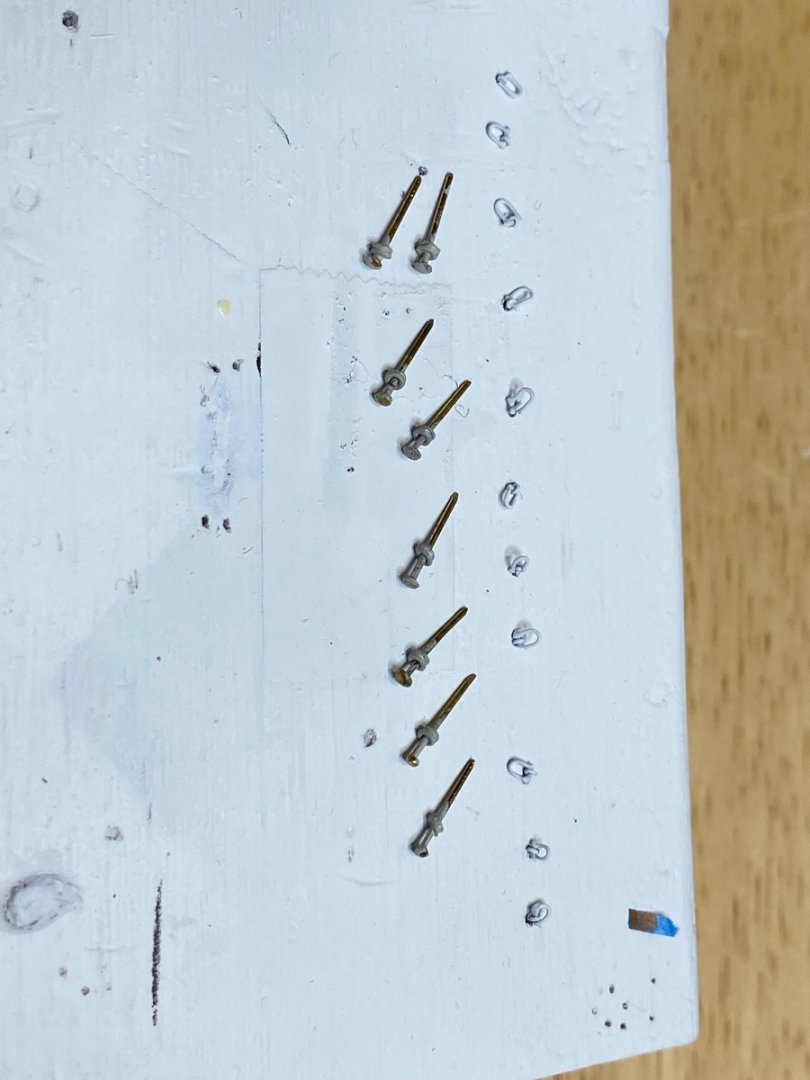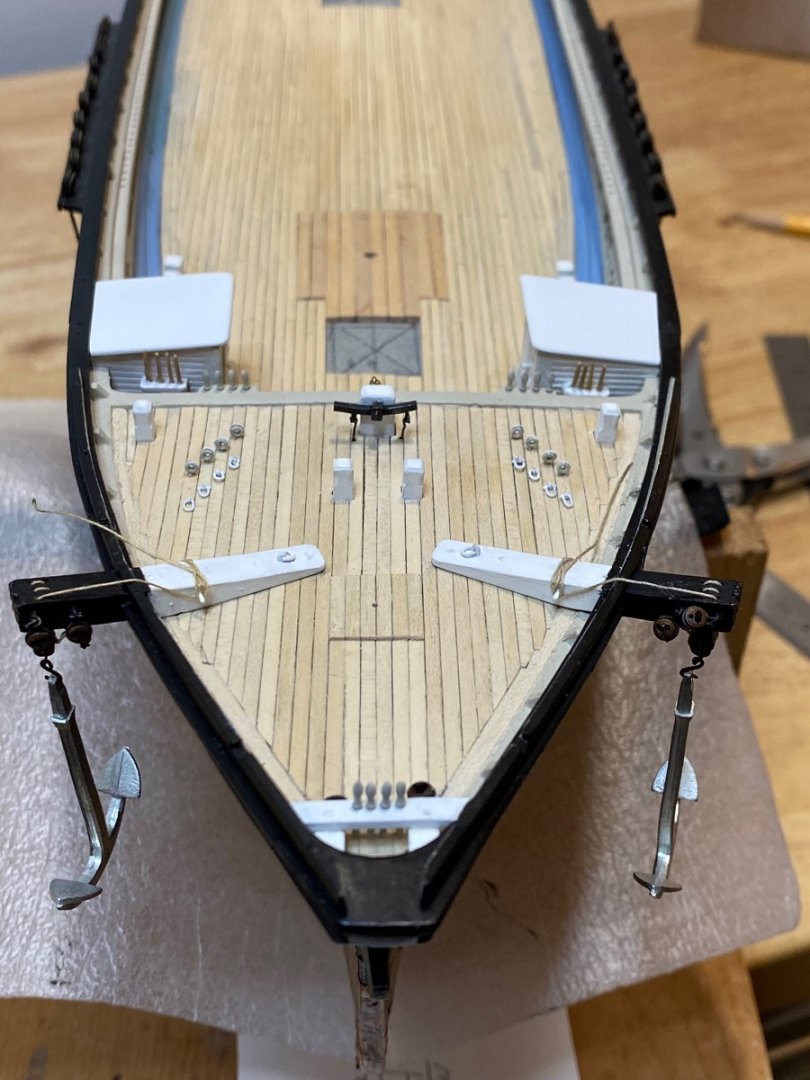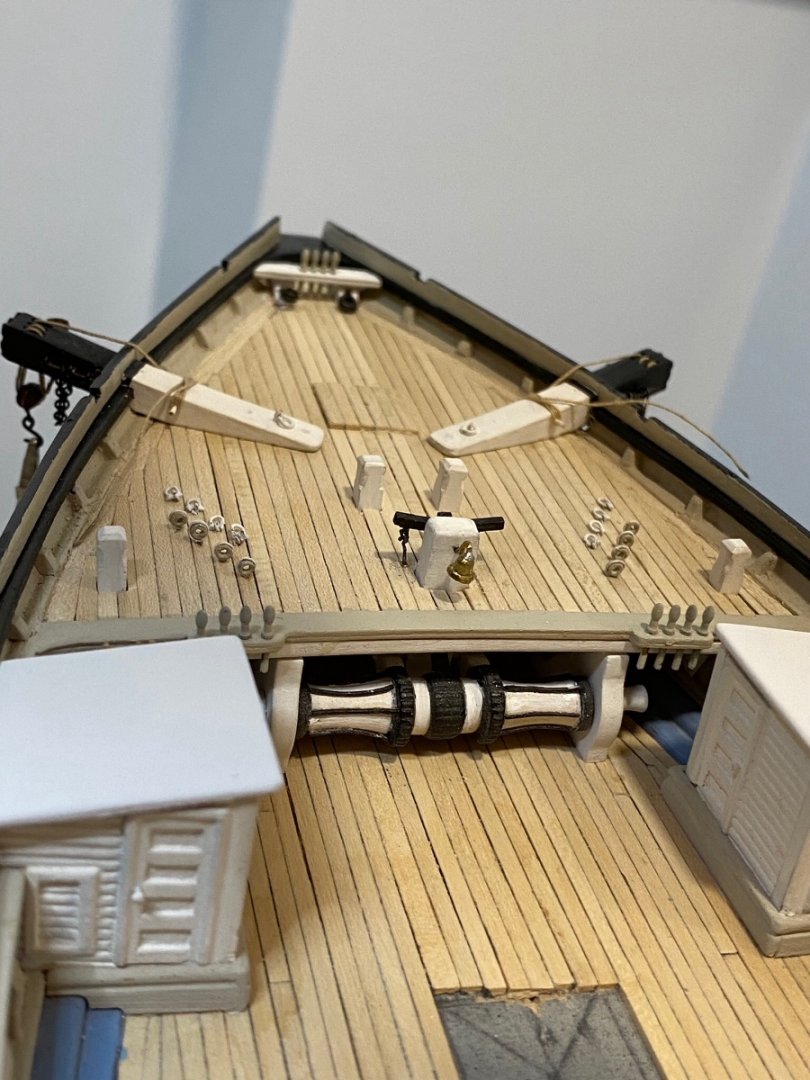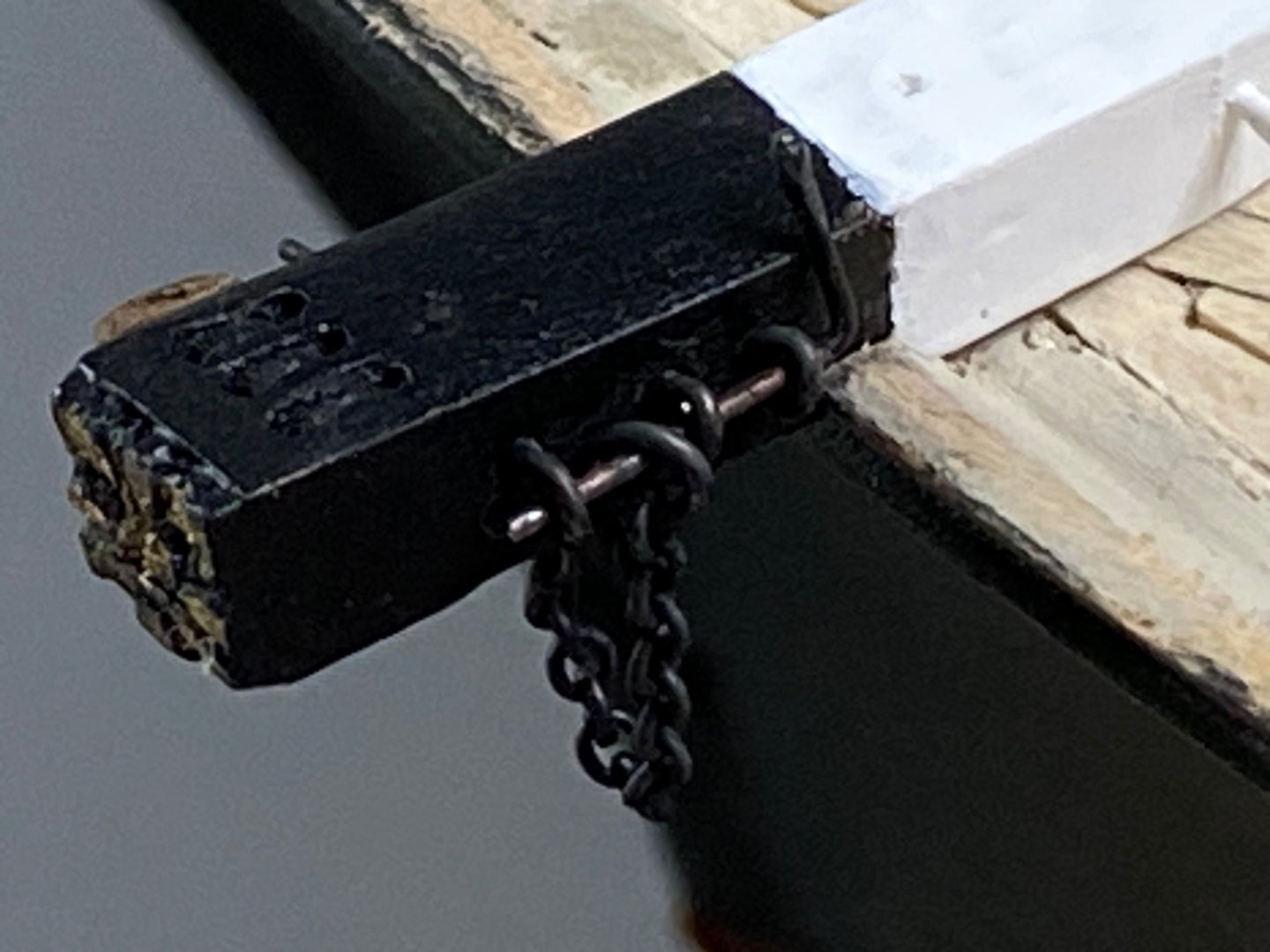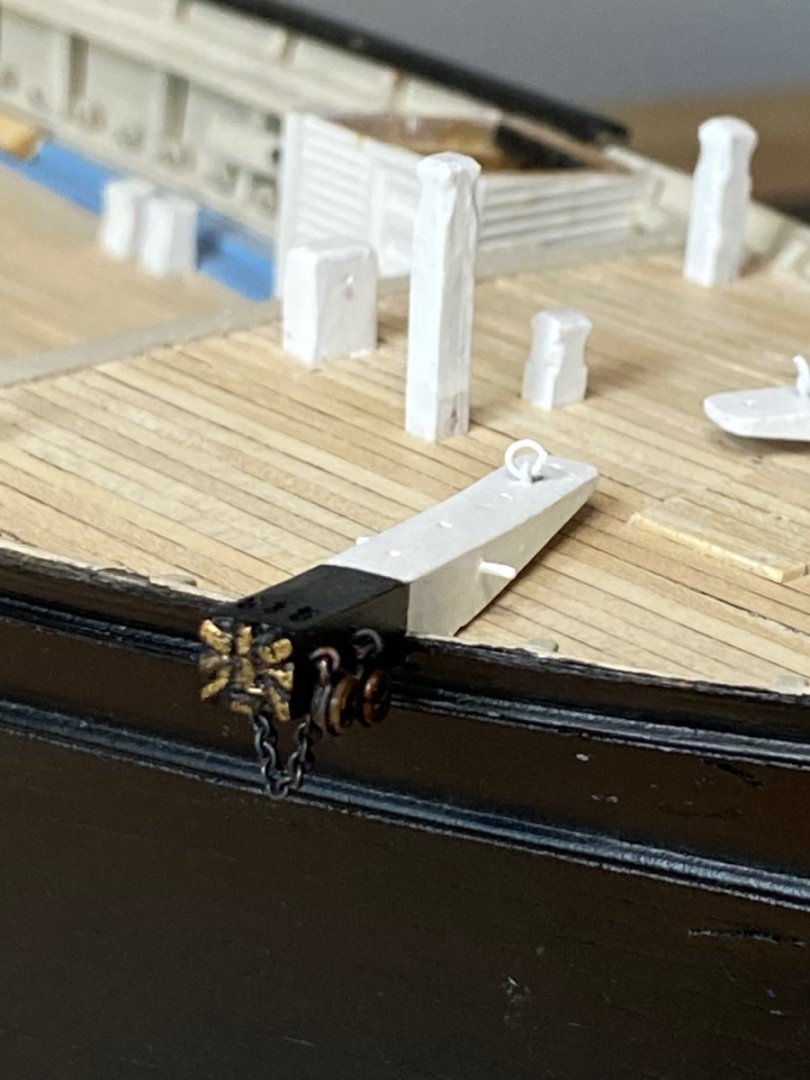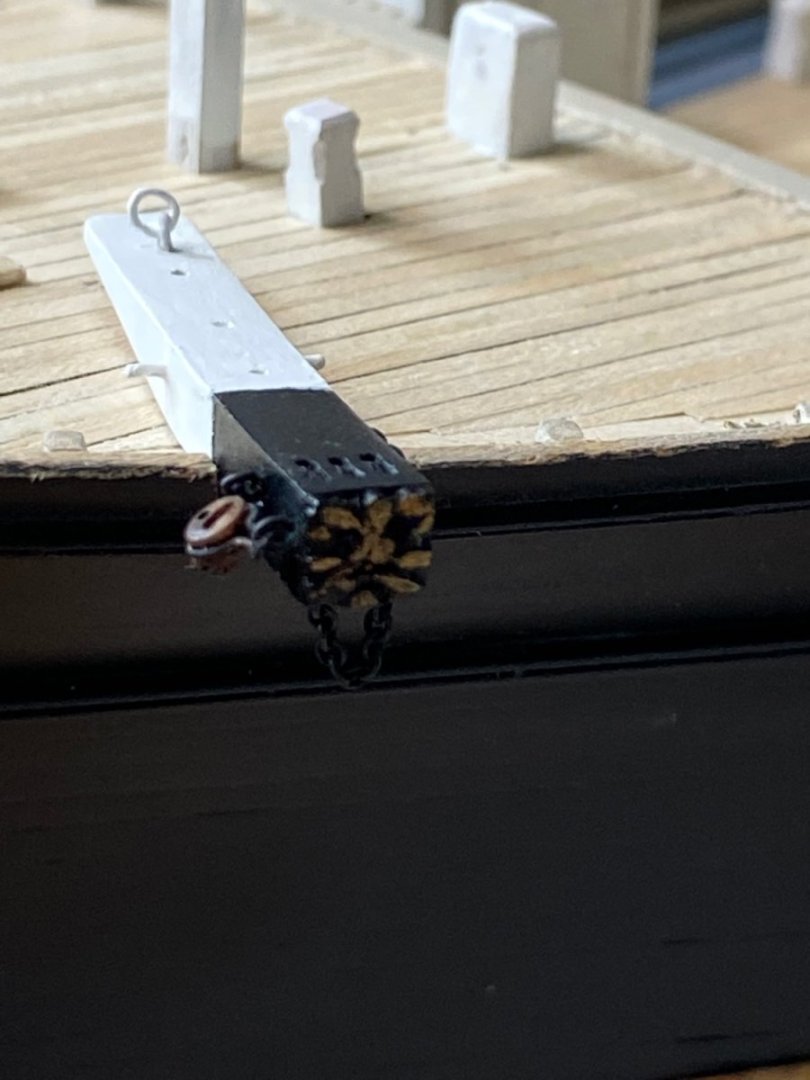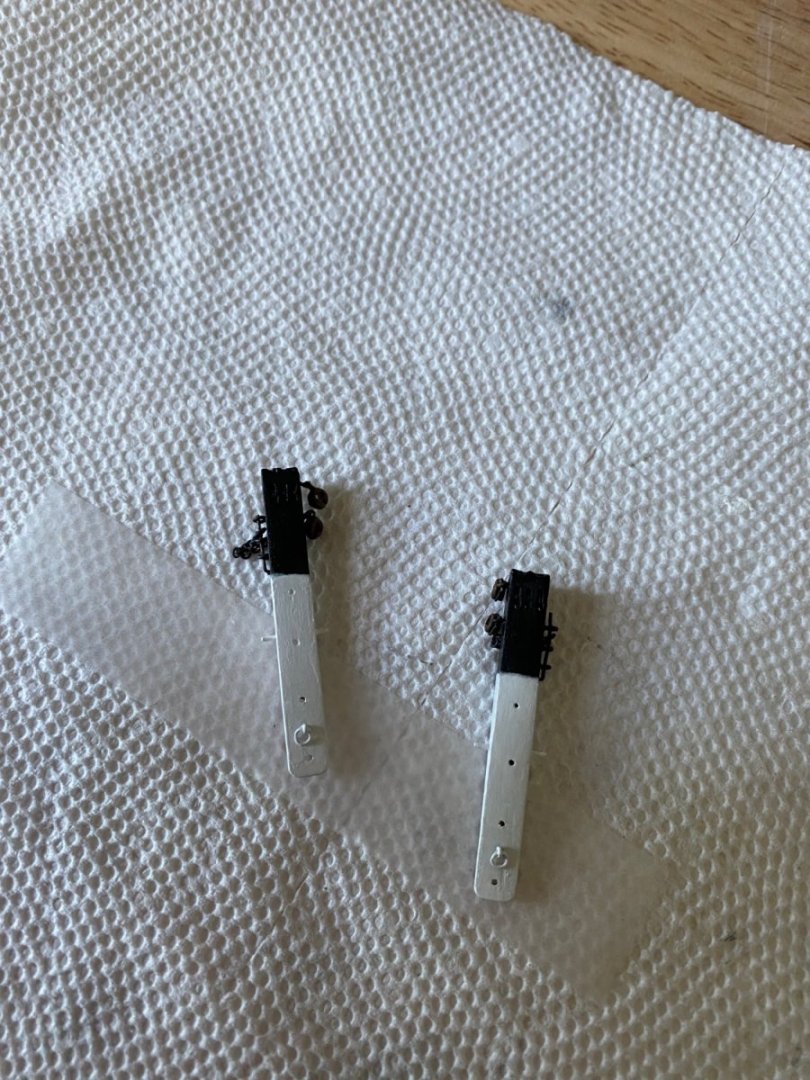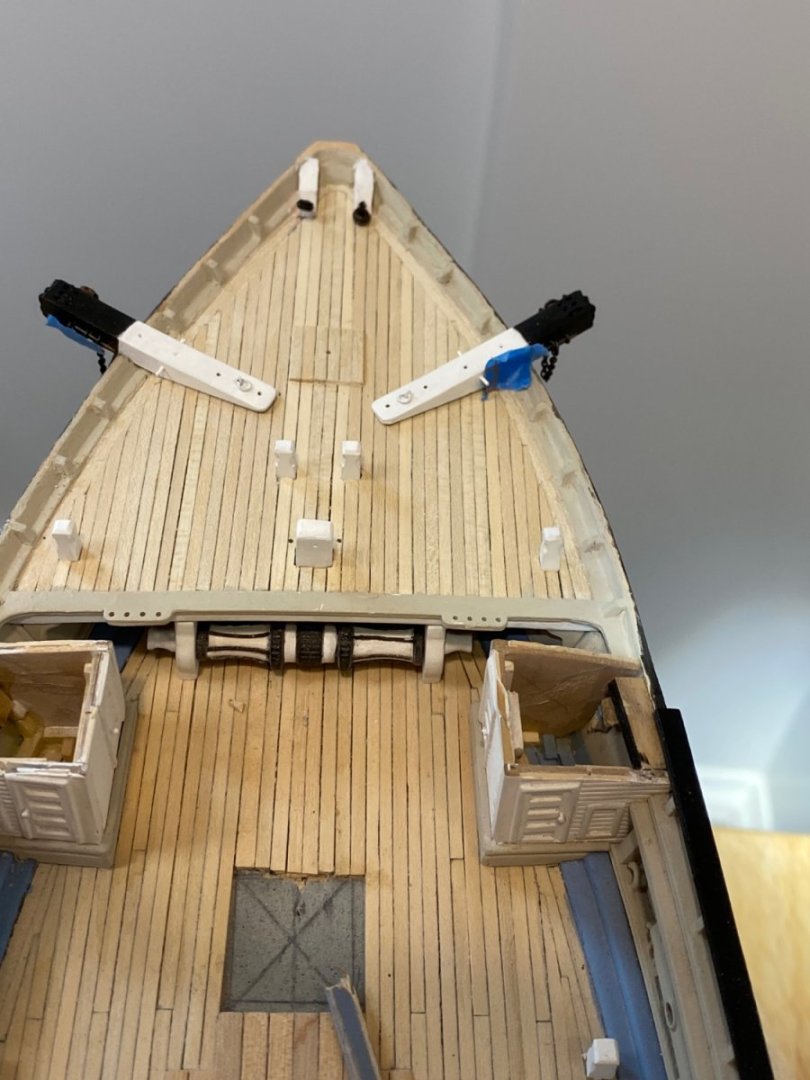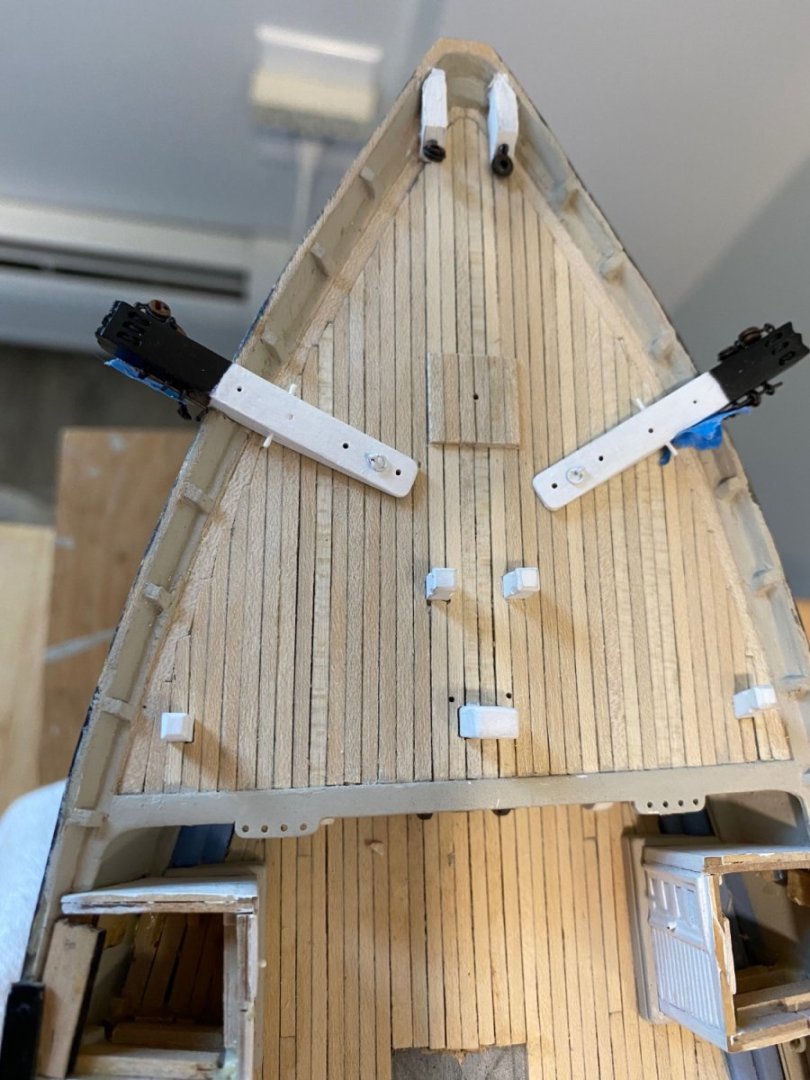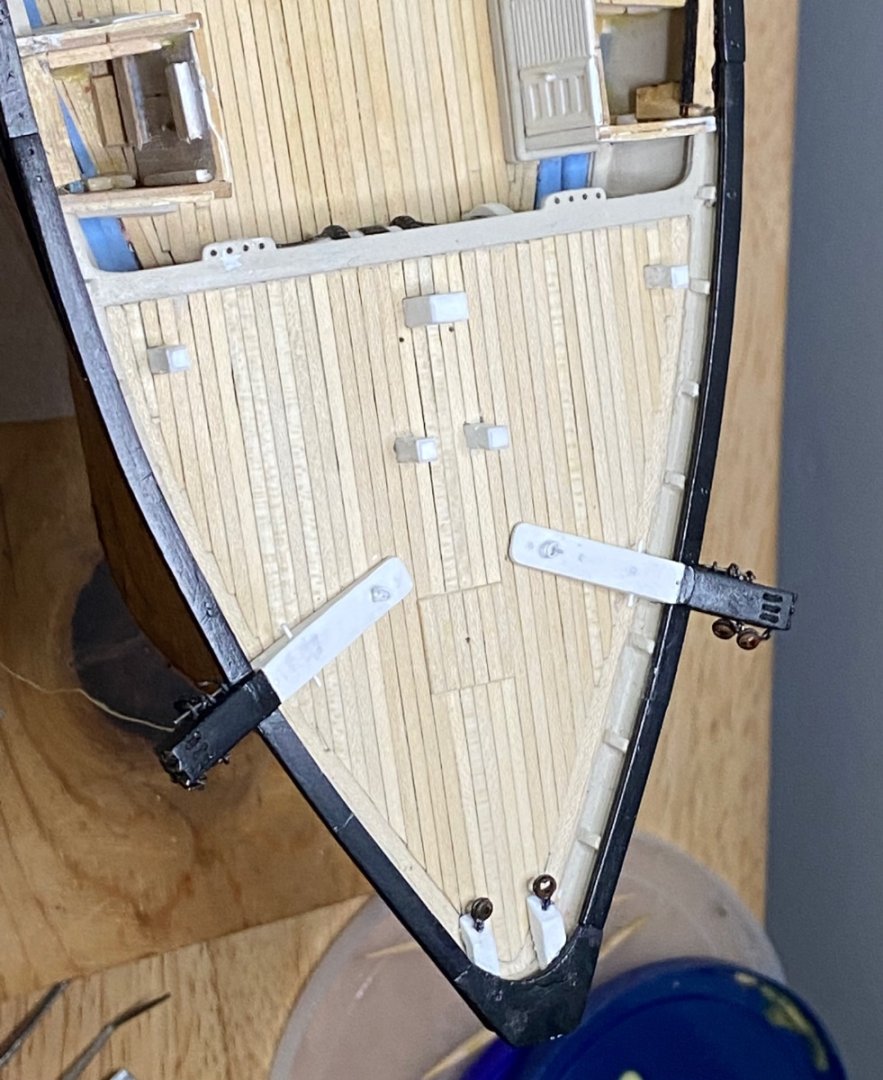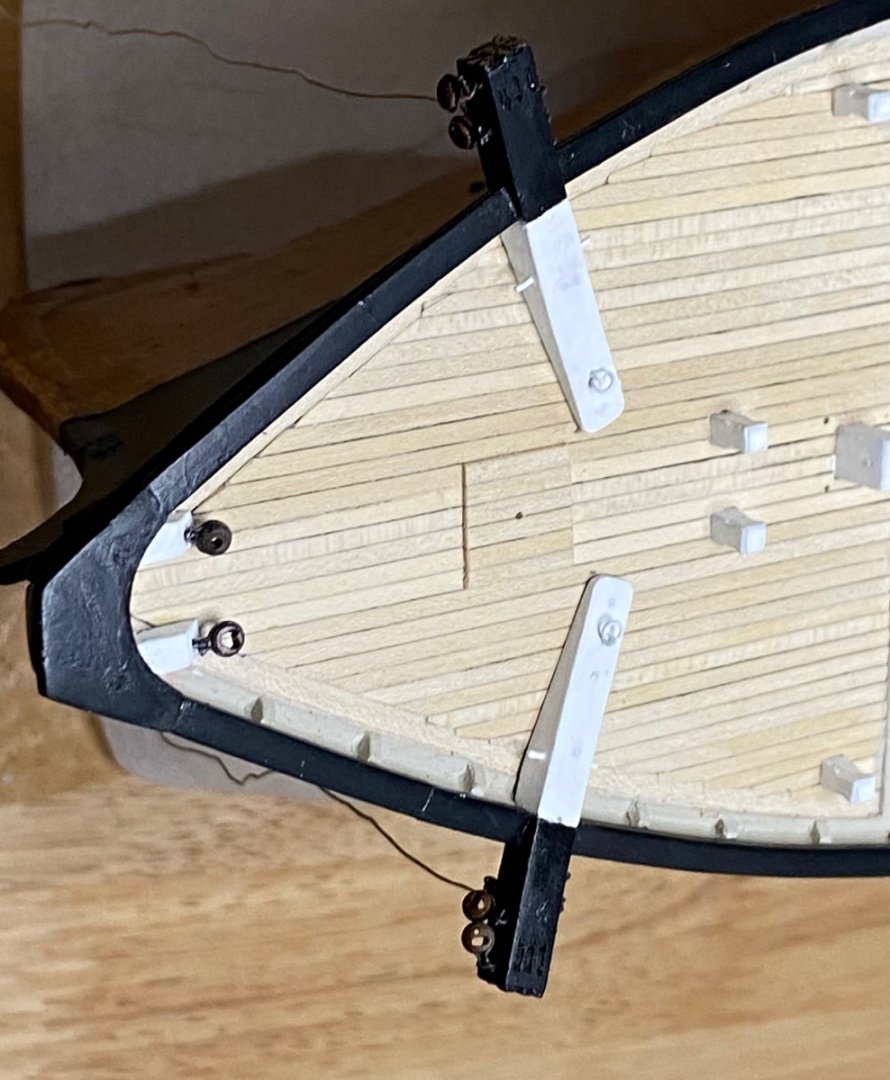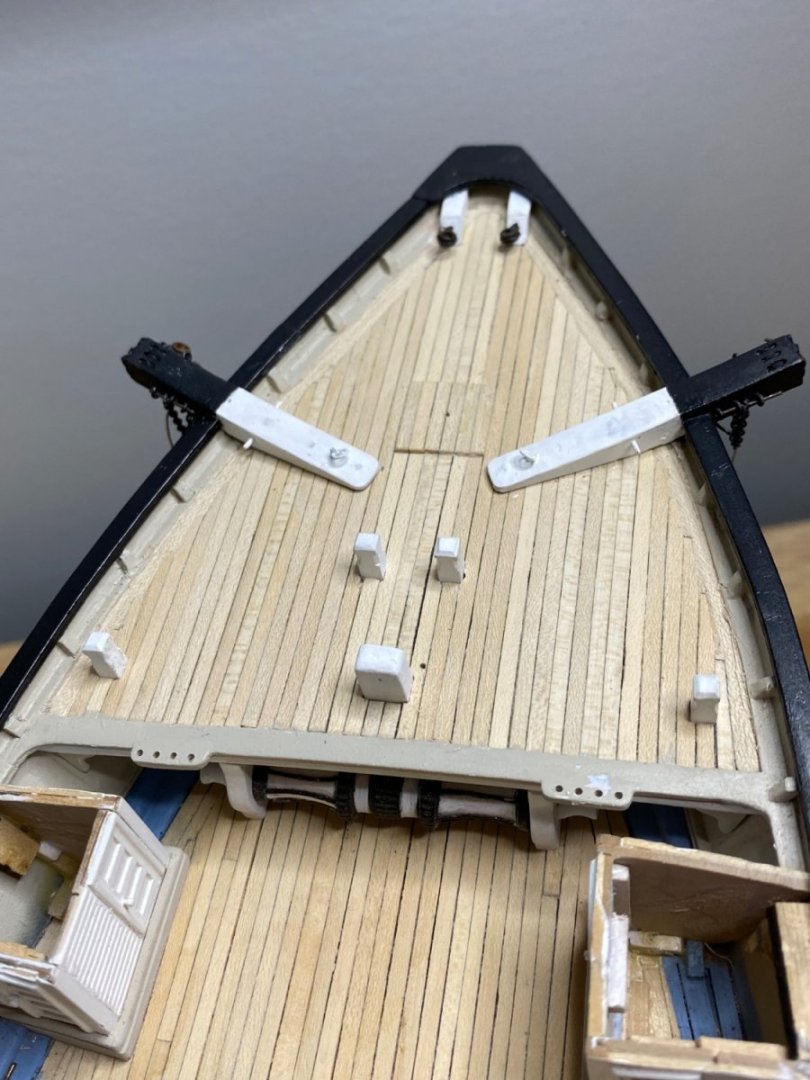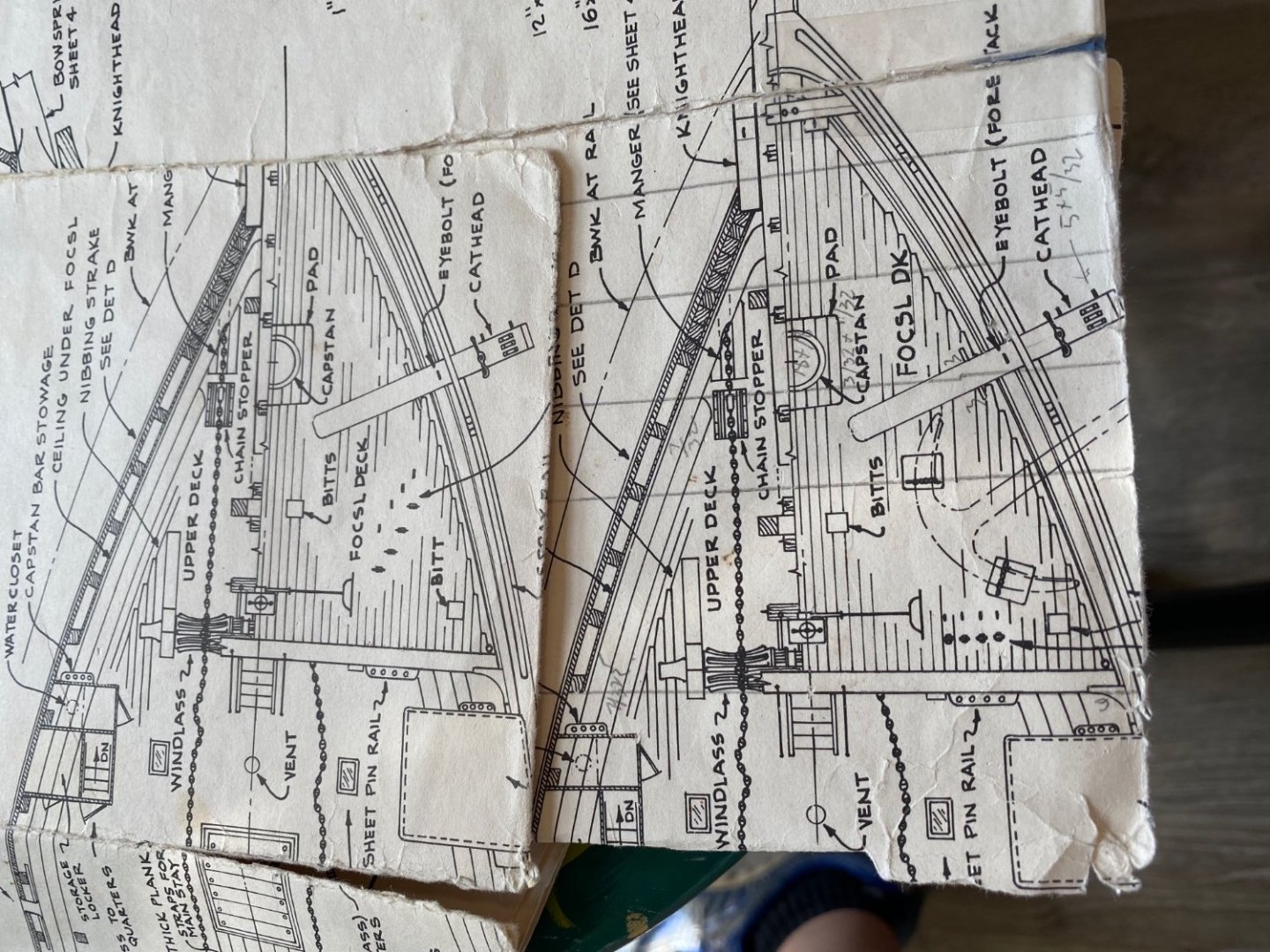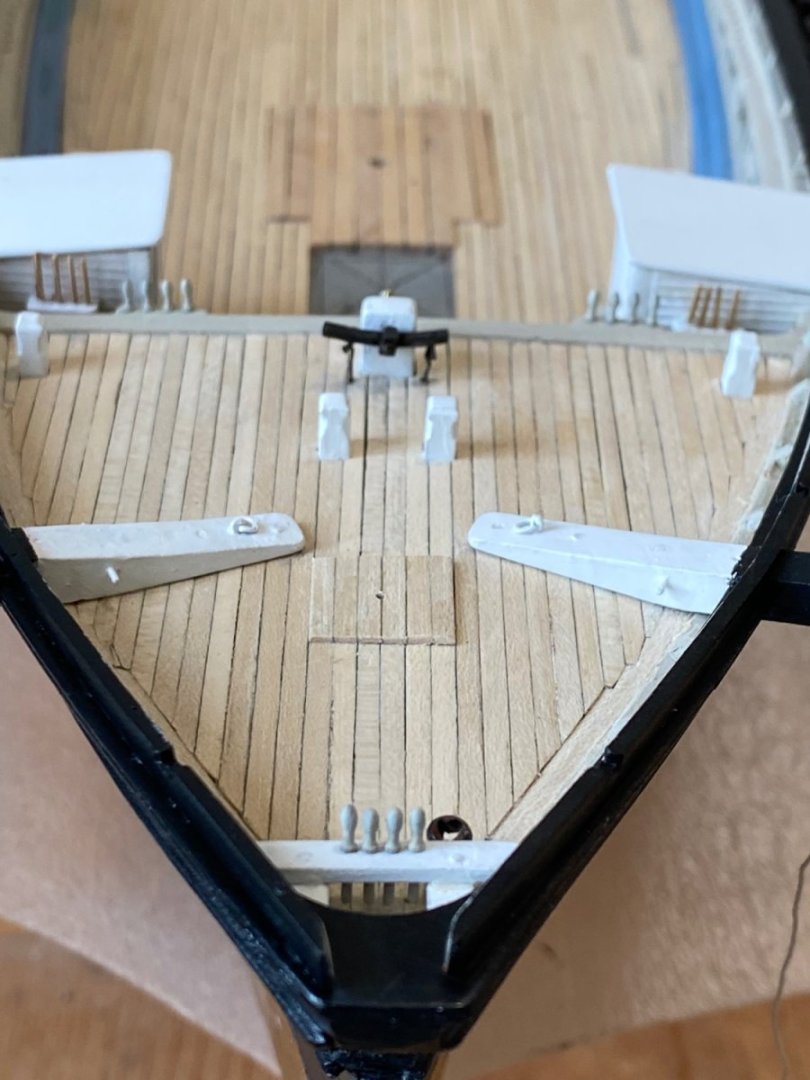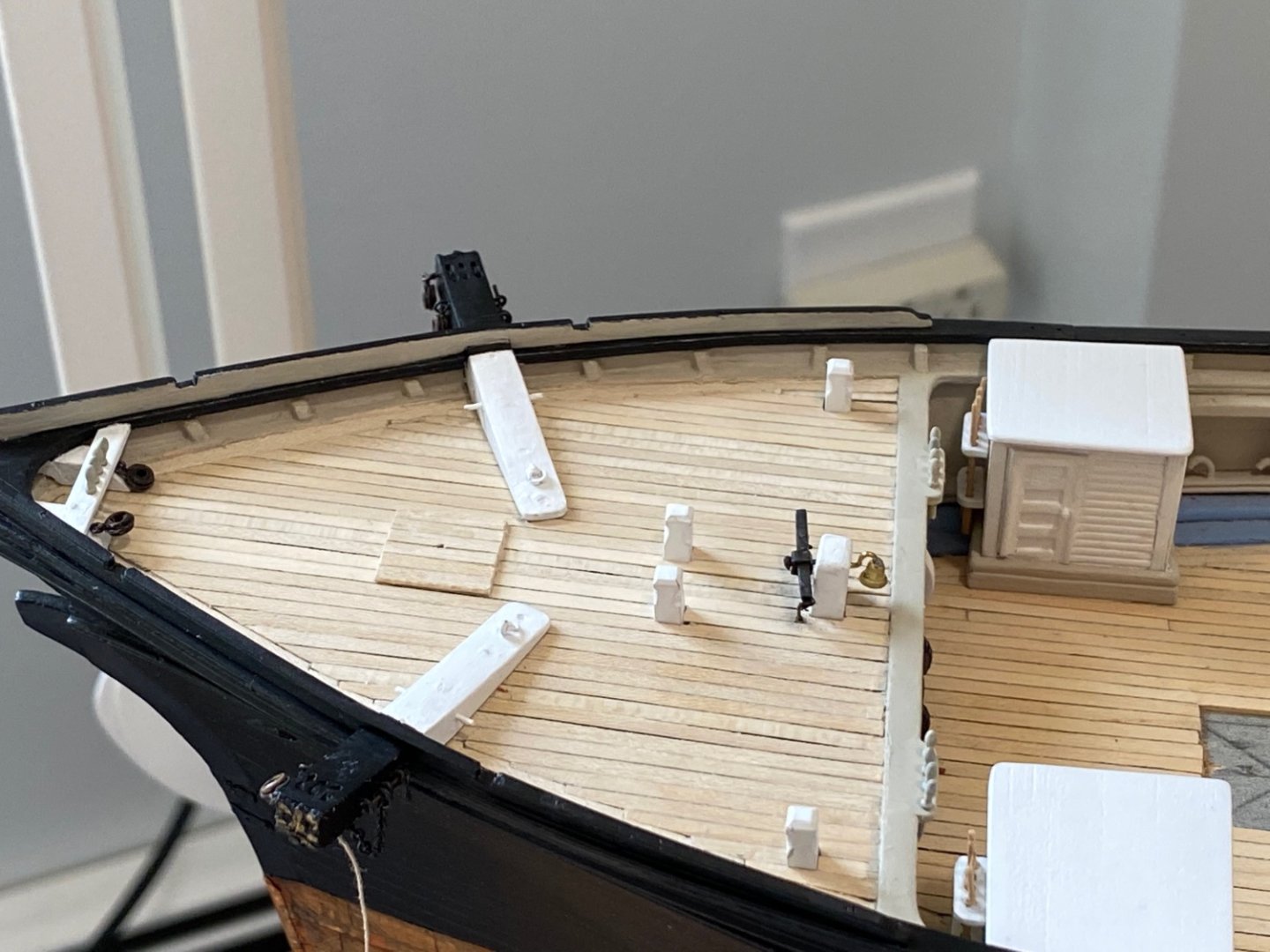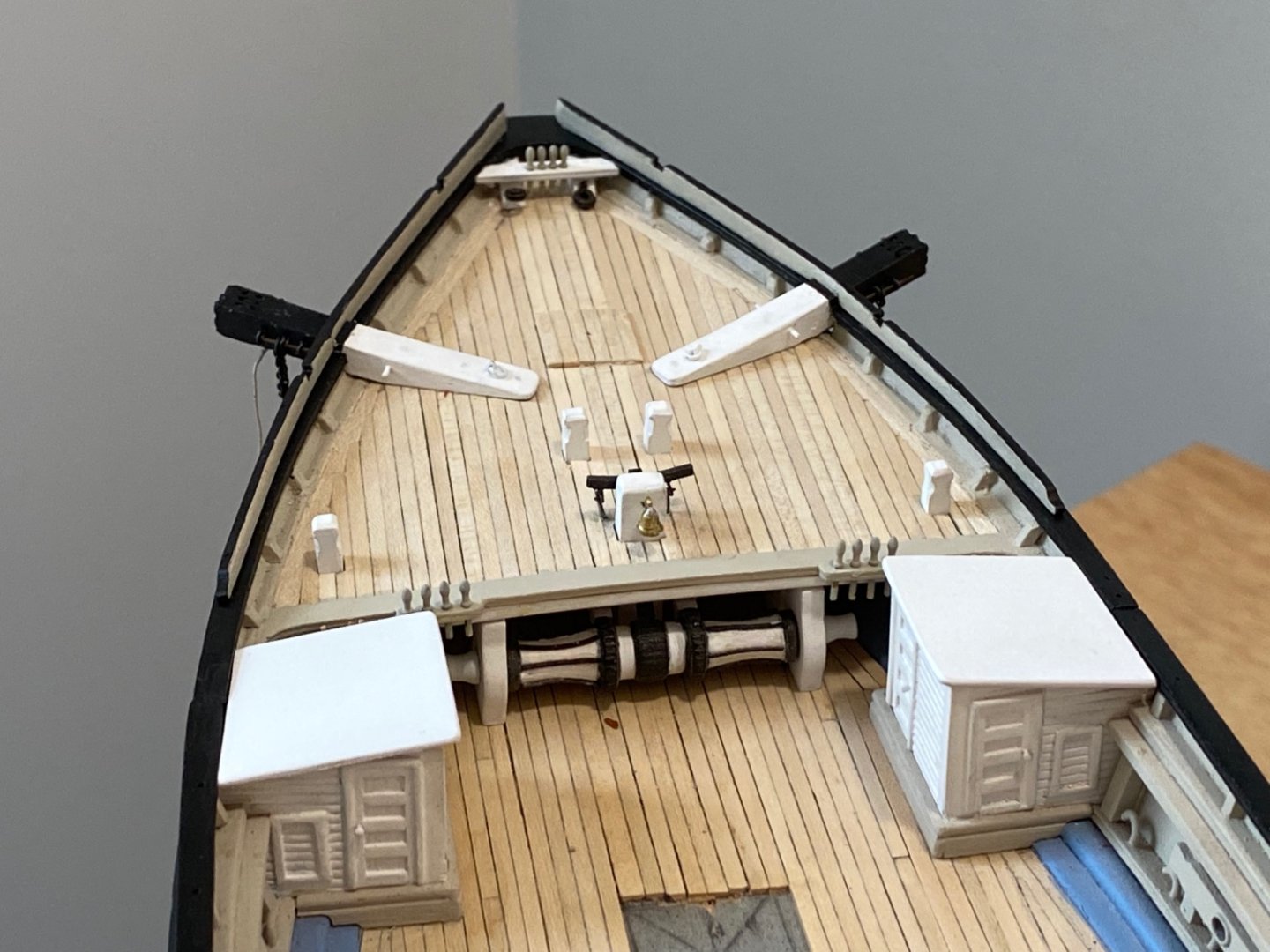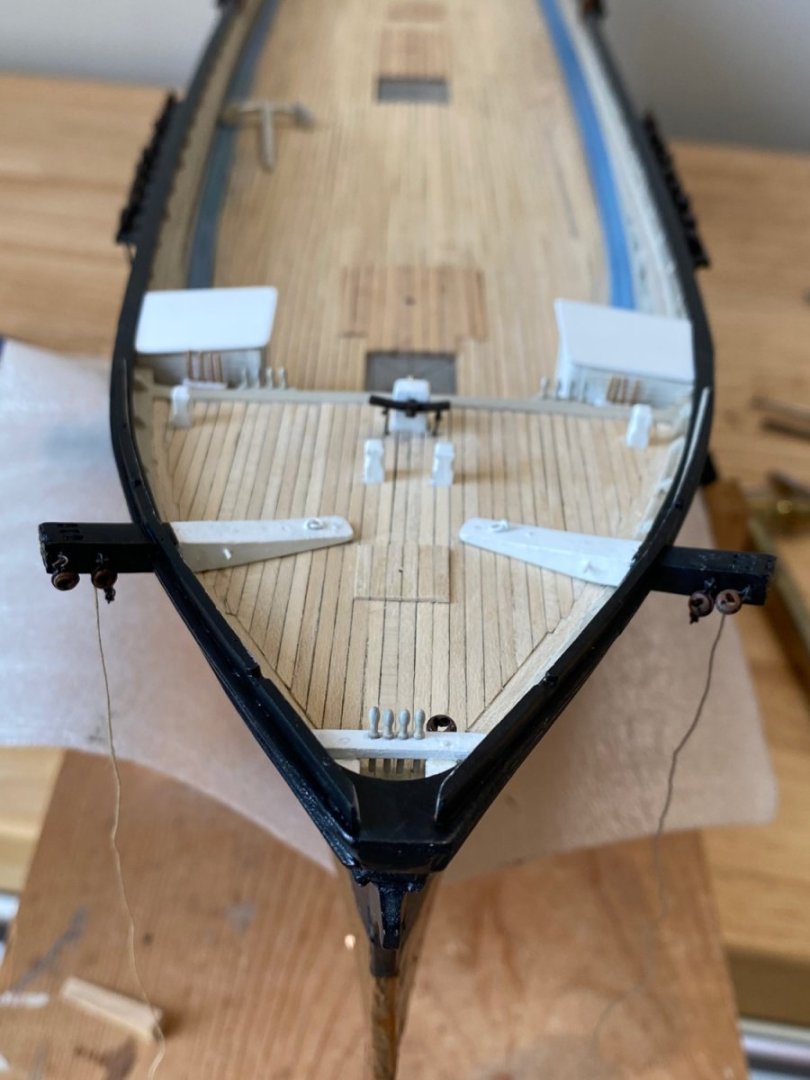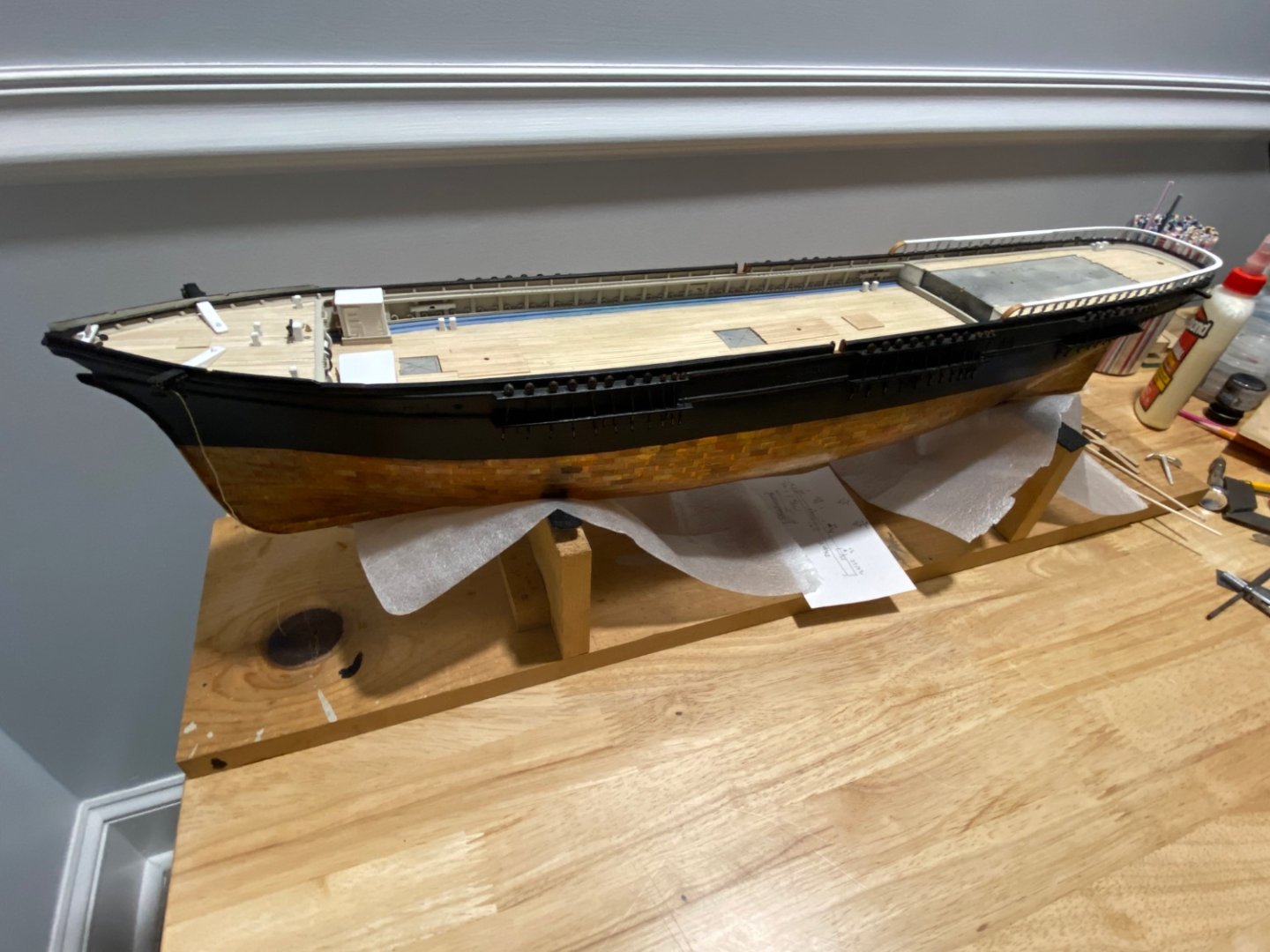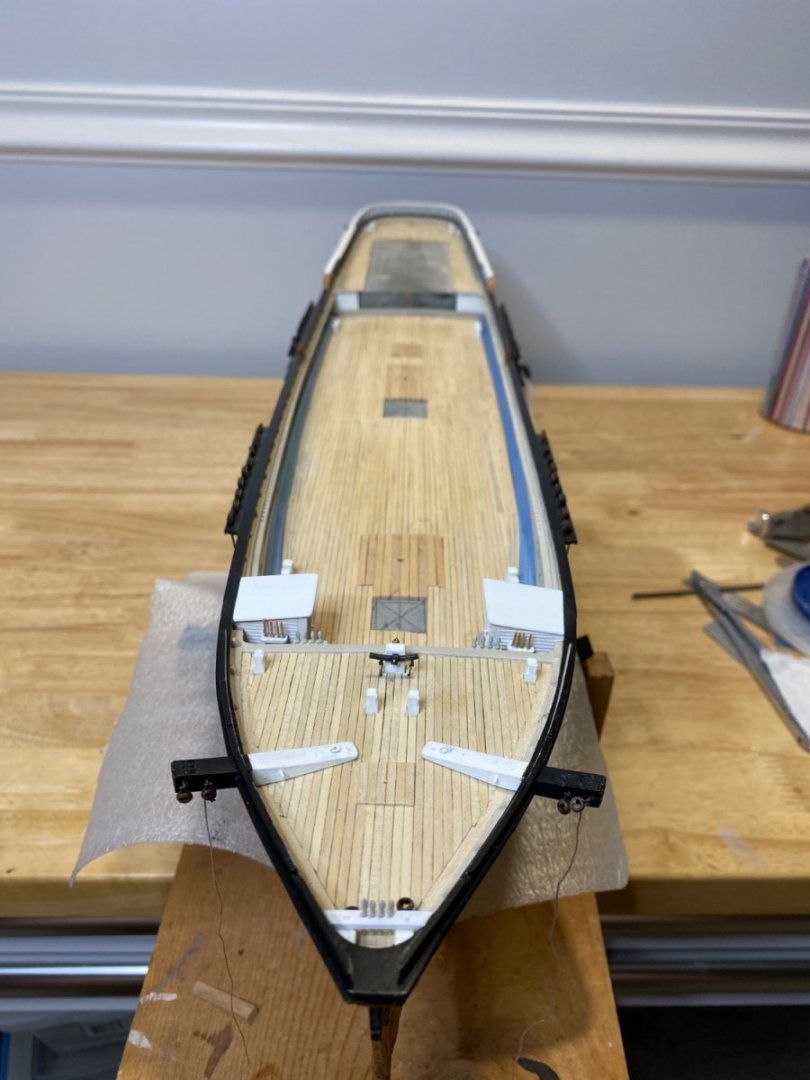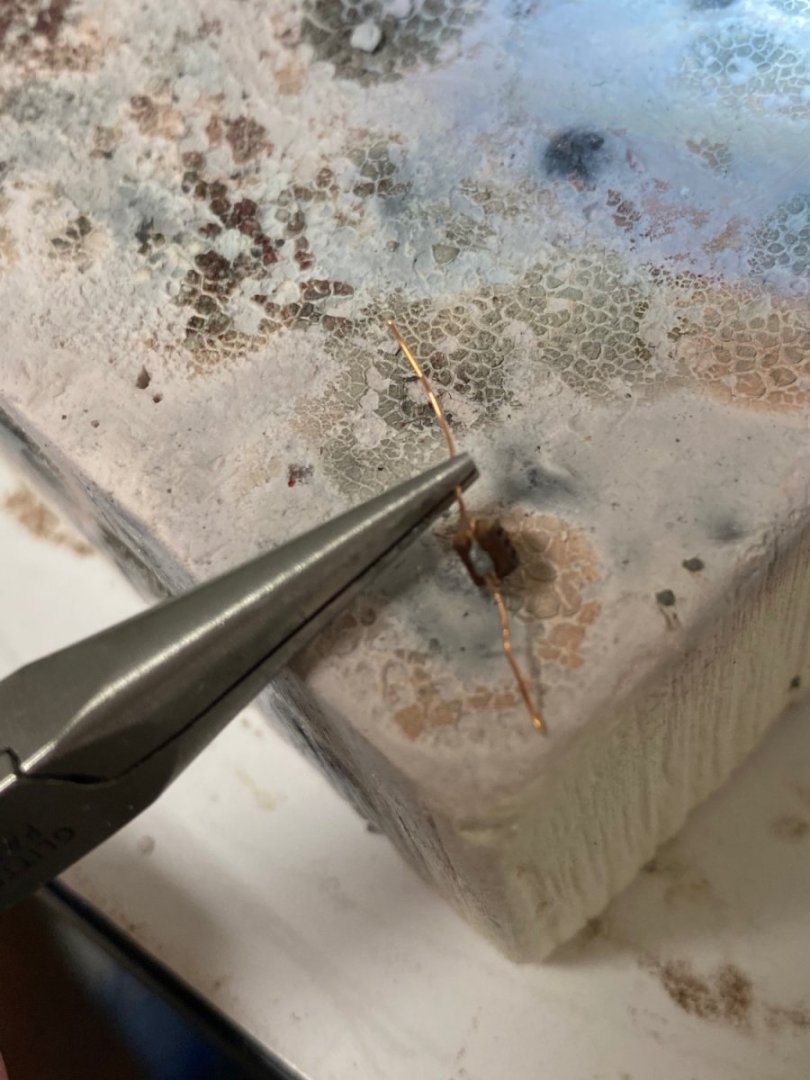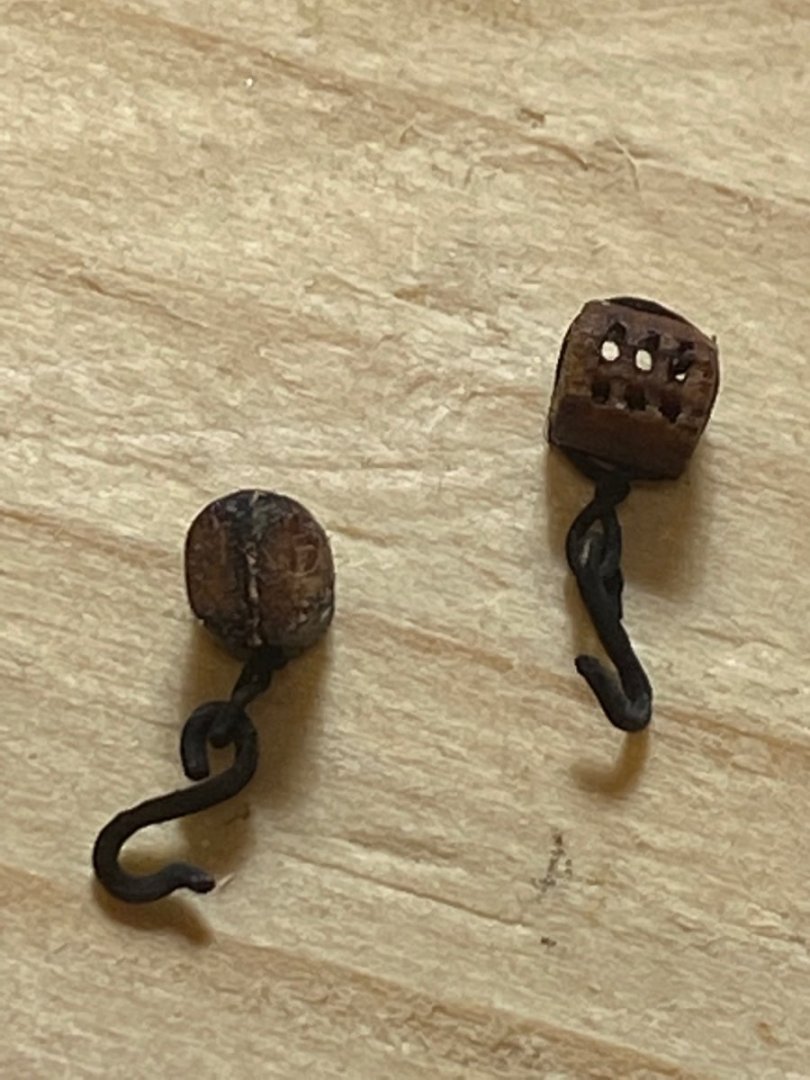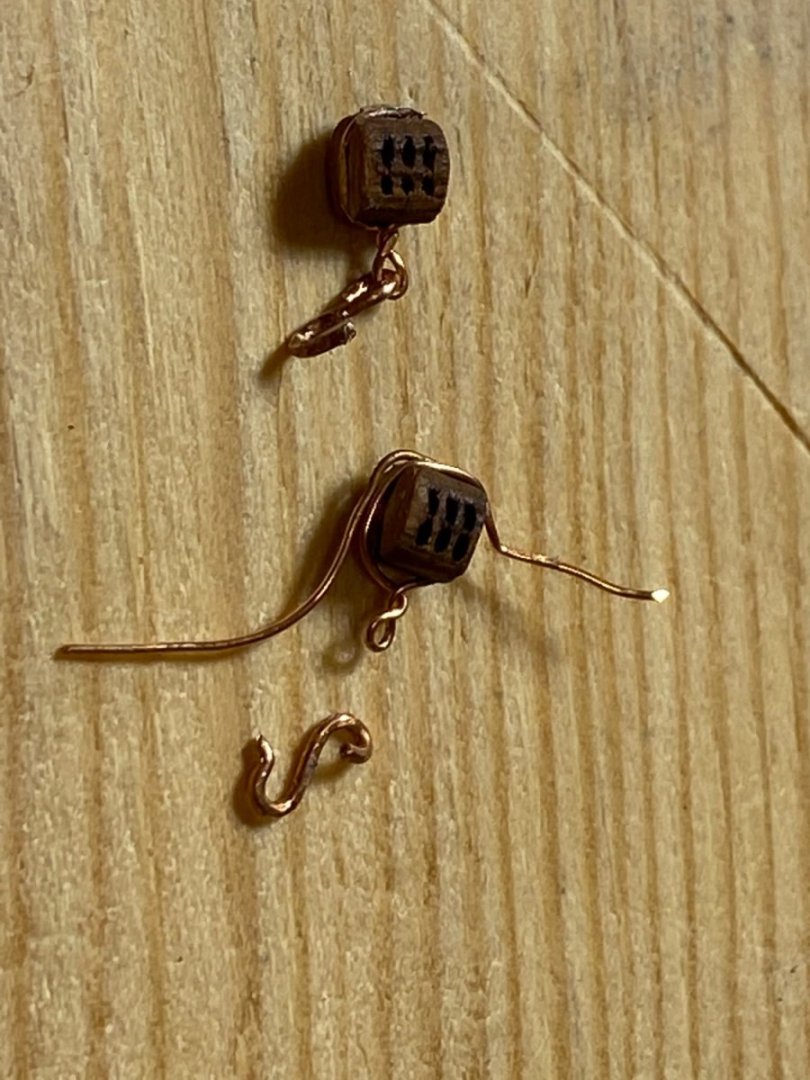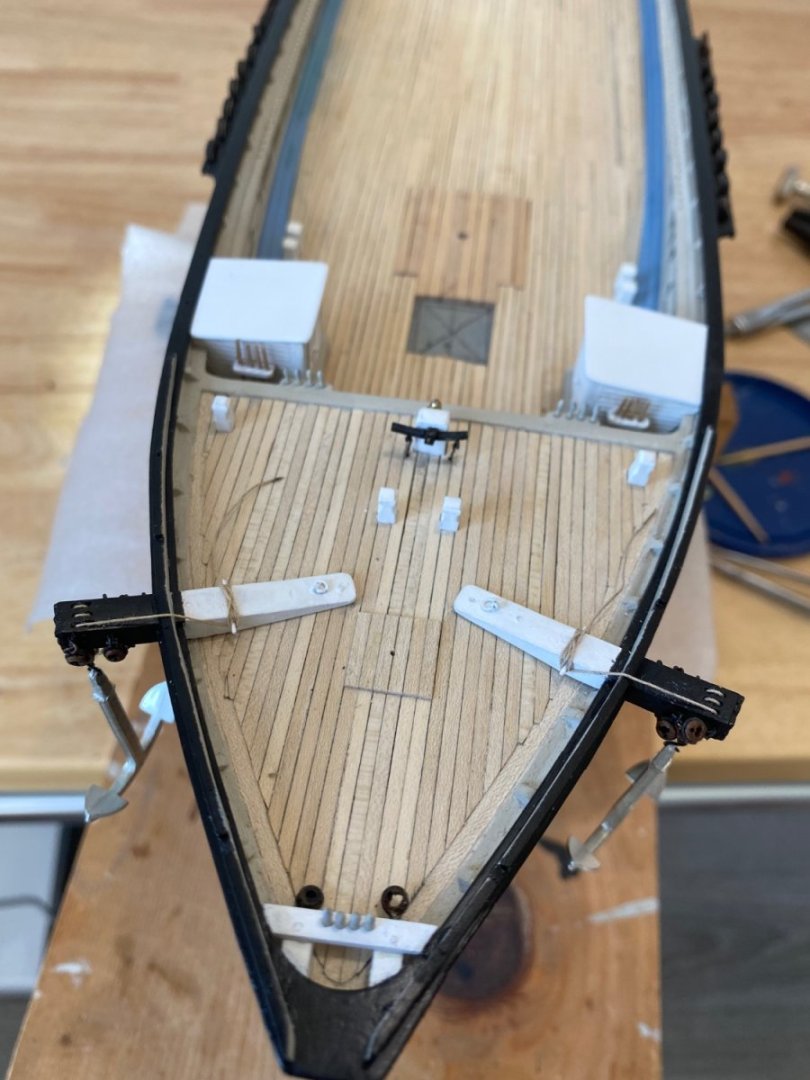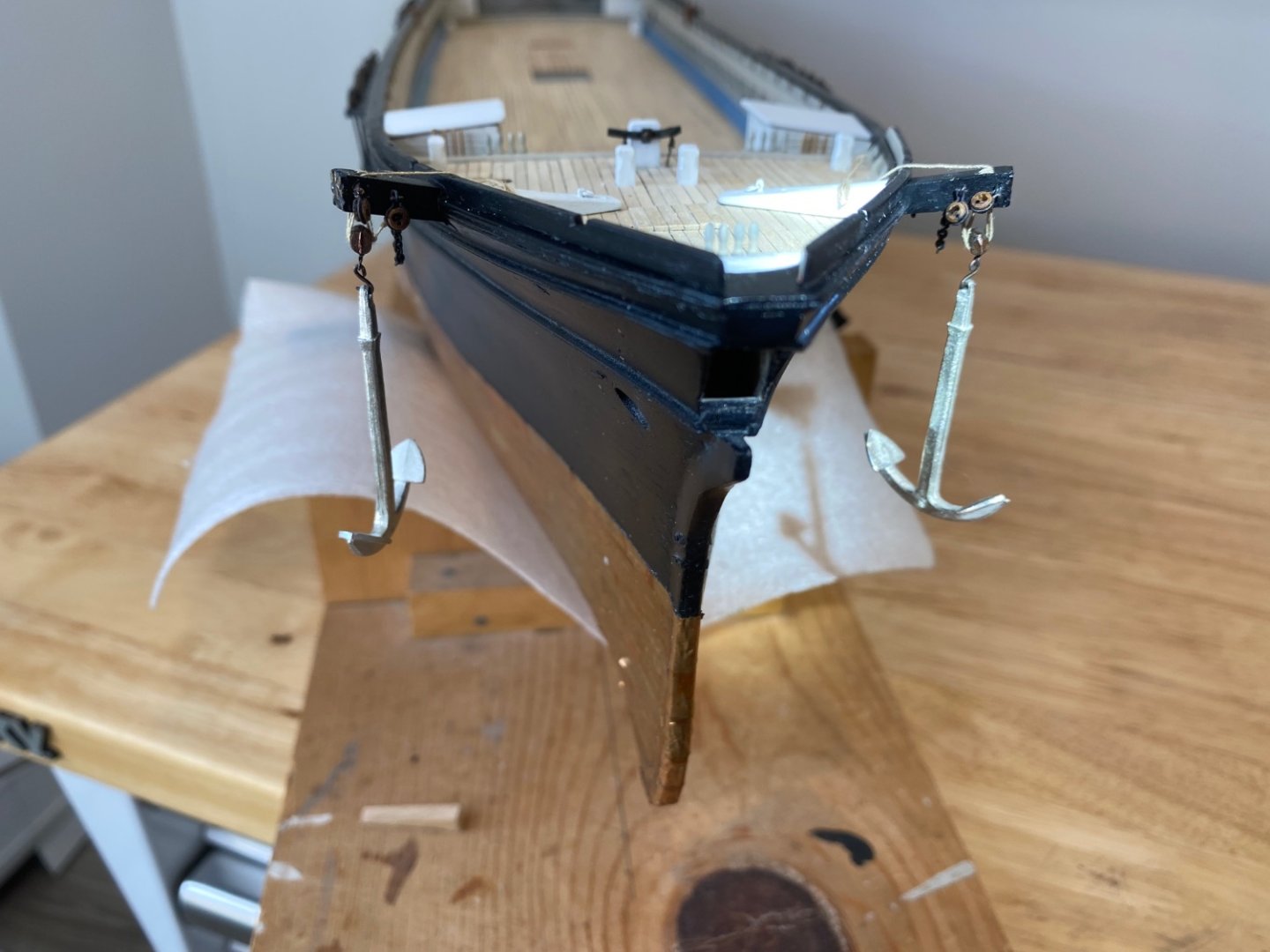
Rick310
NRG Member-
Posts
753 -
Joined
-
Last visited
Content Type
Profiles
Forums
Gallery
Events
Everything posted by Rick310
-
- 343 replies
-
- Flying Fish
- Model Shipways
-
(and 1 more)
Tagged with:
-
Well, it’s been two months since my last post but I have made some progress. I finally finished the hatches . I thought they would be relatively easy and quick to do, but like everything else, they took much longer. The fore and main hatches are build up around a central wood cord. I had previously made the hatch coamings on my Byrnes table saw and so it was just a matter of fitting the combings to the block of wood. The shape of the foaming was copied from pictures of the coamings on the Benjamin Packard. I find that I am not very good at joinery work and I struggle to get a good paint job. It seems like I’m constantly marring the paint and having to re-sand and repaint. All of the coamings had been spray painted pearl gray but when I went back to repaint them I tried to brush on the paint and more often than not I t came out badly. I made the hatch covers out of the boxwood and decided to leave them bright or unpainted. I experimented with applying a wax finish which didn’t seem to do much and left the basement smelling like turpentine, much to my wife’s displeasure. I still have not applied any kind of finish to the deck or the hatch covers and I am unsure whether to leave them as they are or try to apply some kind of finish. Suggestions would be greatly appreciated. I made the ringbolts per Nic at Bluejacket by twisting some 30 gauge copper wire and then bending the loop at 90°. This was then blackened. I had made a jig to drill the holes in the hatch covers on the milling machine for consistency which did not come out as well as I had hoped. Still learning how to use this as well as everything else. The aft hatch has the lazaret on it for access to the cargo hold. This was also build up on a wood core using boxwood trim and some 1/32 inch decking for the sides. This was painted white but I left the rails for the hatch cover bright which were made out of boxwood and stained with Ipswitch pine Minwax stain as were the brackets for the capstan bars. These were probably painted white also but I liked the contrast. The capstan bars are made out of 1/32 square boxwood that I rounded by hand. They did not come out very consistent and hopefully nobody will look too closely. Boxwood does not take stain well as I discovered on the deadeyes. I also made the ring bolts out of 30ga copper wire, 4 for each hatch. This is not on the plans but clearly shows in pictures of the Benjamin Packard. I chose not to include the brackets for securing the canvas covers over the hatches as I was unsure if the Flying Fish had these or if this was a later practice. I also doubt that at this scale, I could fabricate something well.
- 343 replies
-
- Flying Fish
- Model Shipways
-
(and 1 more)
Tagged with:
-
Keith, Just so happens that I live in Belfast Maine which is on Penobscot bay. Cangarda is owned by someone who has a house on Islesboro island In Penobscot bay and has Cangarda hauled out and stored at Front Street ship yard in Belfast. I have walked past and admired her for years. She was on blocks and jacks this past summer, sitting outside. She was not put over and I understand that she is for sale. I used to have pictures of her when tied up at the dock. She is currently back in the shed for the winter. I have some access via our son in law who captan’s 2 yachts stored there If you decide to build a model of her, I might be able to get some pictures. Rick
-
Extraordinary Rob!! Incredibly well done!!! It’s an absolute masterpiece!!!
- 3,560 replies
-
- clipper
- hull model
-
(and 2 more)
Tagged with:
-
Incredible Rob! I am particularly impressed with how great a job you did painting the deck houses and other structures. I seem to be struggling to get my painting clean and crisp as you have. What is your technique? And how did you make the sails? Again, thanks for a great journey. I’m sure you have inspired all of us to keep moving forward and getting better Rick
- 3,560 replies
-
- clipper
- hull model
-
(and 2 more)
Tagged with:
-
All of our models have errors. My frustration was that when I attempted to correct those errors, I often made them worse requiring more time to correct errors with little expertise to do so. I eventually became frustrated and hesitant to move forward. What I have learned is to slow down and constantly check my measurements. I also find that writing things down really helps. Most of all I think is just accepting the fact that this is not perfect and realizing when good enough is good enough. I constantly have to remind myself that while striving to do my best, that the worst enemy of good is better.
- 34 replies
-
- Flying Fish
- Model Shipways
-
(and 1 more)
Tagged with:
-
Welcome to the club, those of us building the Flying Fish and other McKay vessels! I certainly sympathize with the frustration of building the Flying Fish and being unhappy with my results. This led me to abandon the project for several decades until I was able to come to terms with the fact that this was not going to be a “museum quality” model and the only way to get better was to go back and correct what mistakes I could and then move on, hopefully getting better as I gained more experience. I still see all my mistakes and wish I could have done better. Fortunately, most people can’t see them and almost no one cares like we do. I also told myself that when I finished this model, I would build it again and correct all my mistakes. So I purchased the plank on bulkhead version ( mine is the old solid hull version). Now I just hope to get this one finished before I pass away or my wife and family murder me as they are sick and tired of me obsessing on it. LOL.
- 34 replies
-
- Flying Fish
- Model Shipways
-
(and 1 more)
Tagged with:
-
I forgot to add photos of the Star of India last night. I made the shackles and eyebolts as described by EdT. I slipped the eyebolt onto the horseshoe of the shackle and then soldered the bolt. I had difficulty moving the eyebolt around the solder joint onto the bolt, and when I made the eyebolt larger to more easily slip on to the bolt, it wouldn’t stay on the bolt. I found, however that if I kept the eyebolt larger, after I slipped it onto the bolt, I could hold the horseshoe with a pair of parallel pliers and tighten the eyebolt without deforming the shackles bolt. Note on the Star of India, the standing end of the jib sheets are are held to the eyebolts with sister hooks. next up are the hatches.
- 343 replies
-
- Flying Fish
- Model Shipways
-
(and 1 more)
Tagged with:
-
Rob and Clipperfan, Sorry it has taken so long to respond. I really appreciate your interest and suggestions. I have not yet decided what to do about the naval hood. I’m going to try and finish the deck structures first then come to a decision. I was debating where to place the head sheet shackles and fairleads. The original plans for the flying fish show a staggered arrangement which does not include room for belaying the anchor when brought in board. The updated plans show the anchor belayed on deck which leaves the shackles and the fairleads too close together and too close to the aft pin rail on the forecastle. I ended up staggering the shackles and the fair leads as shown on the original plans, but with different spacing. The shackles were made from 26 ga copper wire as were the eye bolts. These or painted white per the star of India. The fairleads were made from 1/16 inch pewter bull’s-eyes purchased from blue jacket. They should have been made of wood but I was unable to make them at this scale. These are painted gray to look like the weathered wood fairleads on the Star of India. The anchors that came with the model shipways kit seem much too large and out of scale. I replace these with two anchors from Bluejacket that go with their red jacket clipper ship model. These look much better and much more to scale. I intend to make the anchor stocks myself. The cat head tackles, I purchased from model expo triple shieve blocks from Falconet. These are beautifully made although a bit expensive. The hooks were made from 26 gauge copper wire and the straps for the blocks from 28 gauge wire. After an eye was formed in the 28 gauge copper wire, it was wrapped around the triple block with the eye centered at the bottom (or as best I could) and soldered in place with a soldering iron after the copper wire was cleaned with acetone. The hook was then attached to the eye, the ends clipped off and the copper blackened. The Cathead tackles where then rigged with thread from Syren ship model co. Additional items like the pumpbrake and bell were also installed as were the belaying pins.
- 343 replies
-
- Flying Fish
- Model Shipways
-
(and 1 more)
Tagged with:
-
George, WOW!!! What a great idea. They look really good !! I’m going to try something similar when I get to that point.
- 602 replies
-
- Flying Fish
- Model Shipways
-
(and 2 more)
Tagged with:
-
It’s been awhile since my last post, but that’s summer in Maine. With outside chores, vacation, work and visitors, work on the Fish has been slow. It was my goal to get the forecastle finished by June, but here it is September and I’m finally finishing it. That plus nothing seems to be easy and takes much longer than anticipated. But here I am. I finished the taffrail which took several tries. I use basswood which I boiled for 15-20 minutes (not long enough). These were placed in a crude jig to get the curve. I installed the section from the companionway roof to the catheads with glue and pins. The cat heads were then finished, I painted the outboard section black and the inboard section white. This paint scheme copies the model of the Snow Squall at the Maine maritime museum in Bath, Me. The 2 hearts for the jib boom guys were added on the fore side while the anchor release mechanism was added on the aft side. The catheads were then glued and pinned with 3 copper bolts. The forward portion of the taffrail was then added. This was difficult because of how the bow sections both port and starboard rails meet. A challenge producing the inside curve. After this, I made and installed the forward pin rail for the head sail sheets. This appears to me to be too crowded but that’s probably because in reality, the belaying pins are out of scale. The next item was to make and install the splash rails. I found these to be finicky and also a challenge to make. I initially used basswood but was not pleased with the several attempts to fabricate them. I then decided to use boxwood which after shaping and cutting in the notches for the mooring fairleads and the cat heads, I boiled them for a half hour then placed them in the the jig to get the curve. This was much more successful which I discovered after re-reading EdT’s Young America. I painted the inboard side Pearl gray to match the bulwarks and the outside black. These are then glued in pinned into place.
- 343 replies
-
- Flying Fish
- Model Shipways
-
(and 1 more)
Tagged with:
-
George, the Bobstays and shrouds look great. I too am struggling how to terminate the foremast shrouds. Drill a hole in the hull and gluing the stays in the hole doesn’t seem to me to be strong enough to withstand the pull of the shrouds. I am considering passing the shrouds through a hole in the hull secured with a knot in the shroud from under the forecastle deck. Tricky and still leaves the fore stay which is doubled. Decisions decisions…
- 602 replies
-
- Flying Fish
- Model Shipways
-
(and 2 more)
Tagged with:
-
Rob. Your work is beautiful. We are always hardest on ourselves. As I look at my model , I see all the mistakes and things I should have done better, but at some point we need to move on if we ever expect to finish the model
- 3,560 replies
-
- clipper
- hull model
-
(and 2 more)
Tagged with:
-
Well done, really looks good. The masts between the doublings would be left bright and oiled to allow the spars to be hoisted and lowered.. even if it appears to be painted. In the Buttersworth painting.
- 602 replies
-
- Flying Fish
- Model Shipways
-
(and 2 more)
Tagged with:
-
This is really well done Rob!! Has a nice clean look to the forecastle. I especially like the way you made the cut outs (chocks?) for the mooring lines in the splash rails. Great attention to detail!
- 3,560 replies
-
- clipper
- hull model
-
(and 2 more)
Tagged with:
-
Looks really good Rob. I think you nailed it!!
- 3,560 replies
-
- clipper
- hull model
-
(and 2 more)
Tagged with:
-
Great question. Don’t know the answer. ClipperFan is probably correct. Makes sense. Mast look great!!
- 602 replies
-
- Flying Fish
- Model Shipways
-
(and 2 more)
Tagged with:
-
George, just saw your post. That is great news! My thoughts and prayers will be with you my friend! Keep up the good work on the flying fish you’re leading the way!
- 343 replies
-
- Flying Fish
- Model Shipways
-
(and 1 more)
Tagged with:
-
Good to hear from you. Hope all is well
- 343 replies
-
- Flying Fish
- Model Shipways
-
(and 1 more)
Tagged with:
About us
Modelshipworld - Advancing Ship Modeling through Research
SSL Secured
Your security is important for us so this Website is SSL-Secured
NRG Mailing Address
Nautical Research Guild
237 South Lincoln Street
Westmont IL, 60559-1917
Model Ship World ® and the MSW logo are Registered Trademarks, and belong to the Nautical Research Guild (United States Patent and Trademark Office: No. 6,929,264 & No. 6,929,274, registered Dec. 20, 2022)
Helpful Links
About the NRG
If you enjoy building ship models that are historically accurate as well as beautiful, then The Nautical Research Guild (NRG) is just right for you.
The Guild is a non-profit educational organization whose mission is to “Advance Ship Modeling Through Research”. We provide support to our members in their efforts to raise the quality of their model ships.
The Nautical Research Guild has published our world-renowned quarterly magazine, The Nautical Research Journal, since 1955. The pages of the Journal are full of articles by accomplished ship modelers who show you how they create those exquisite details on their models, and by maritime historians who show you the correct details to build. The Journal is available in both print and digital editions. Go to the NRG web site (www.thenrg.org) to download a complimentary digital copy of the Journal. The NRG also publishes plan sets, books and compilations of back issues of the Journal and the former Ships in Scale and Model Ship Builder magazines.

